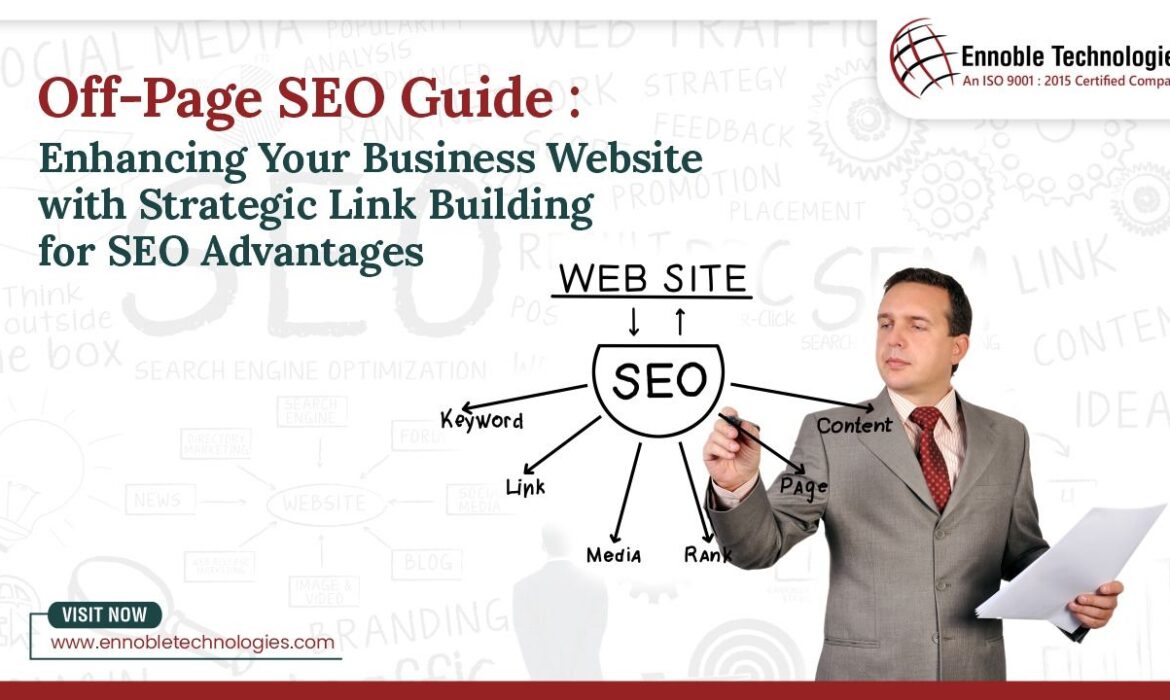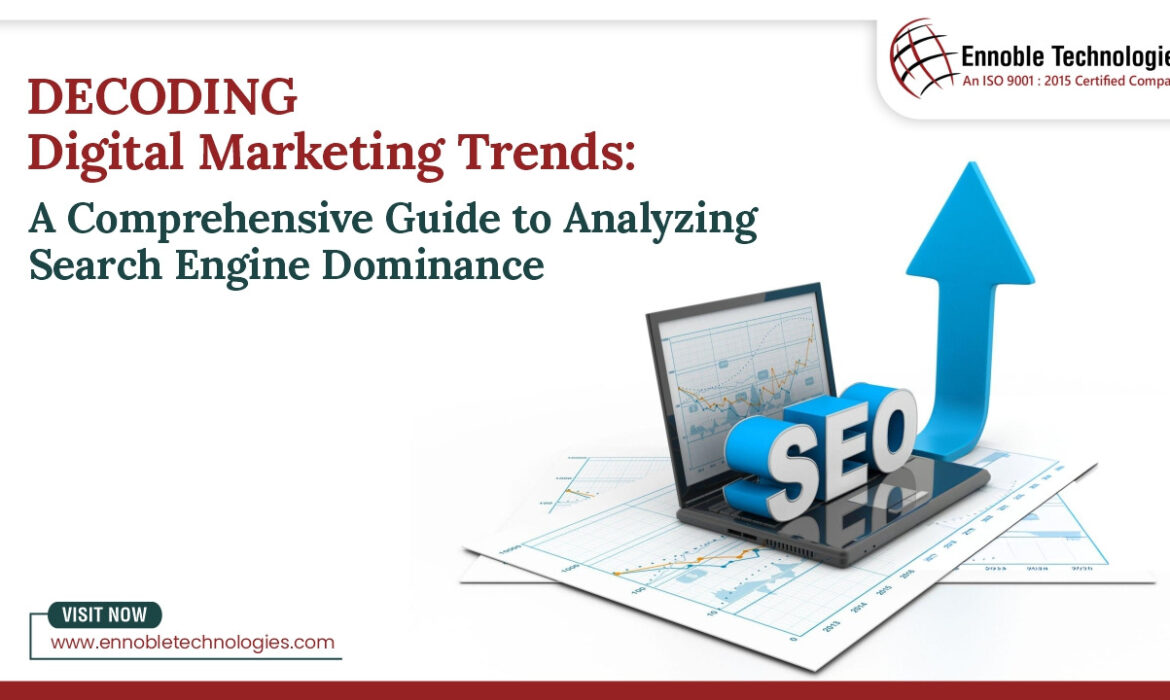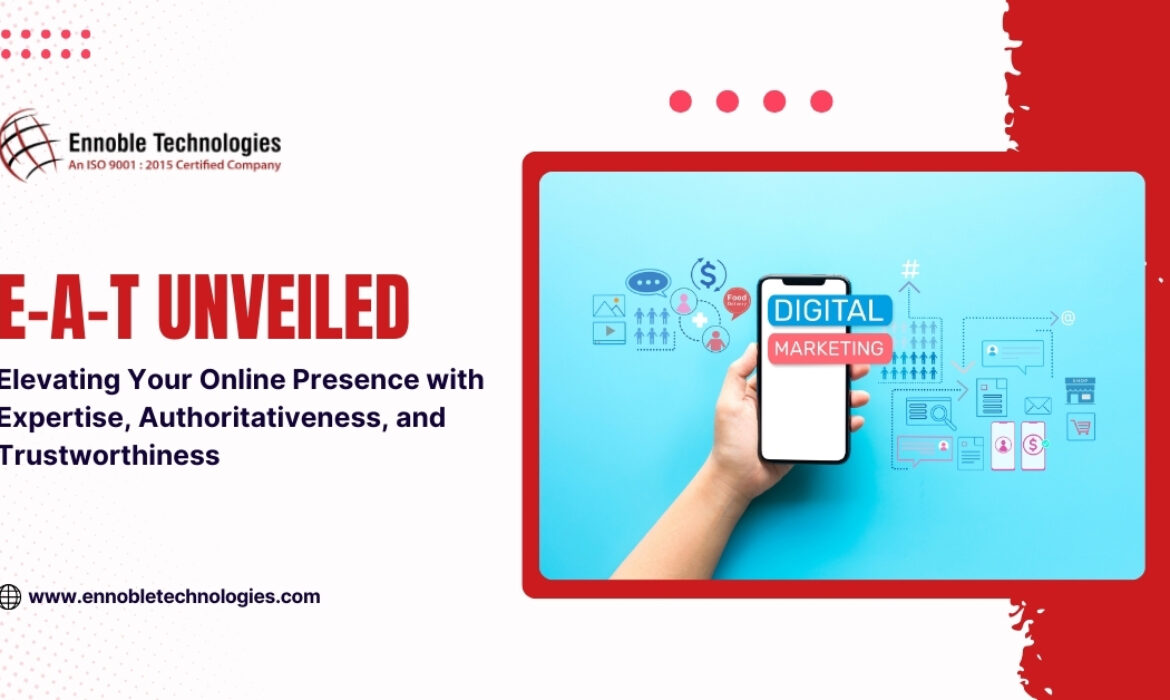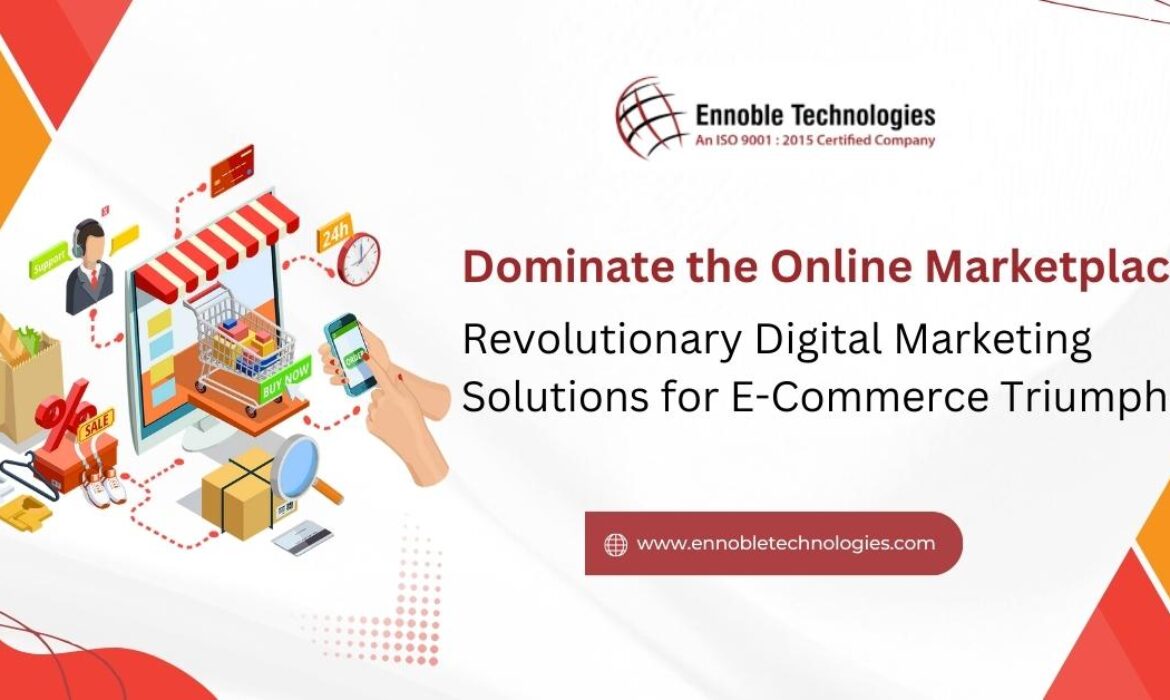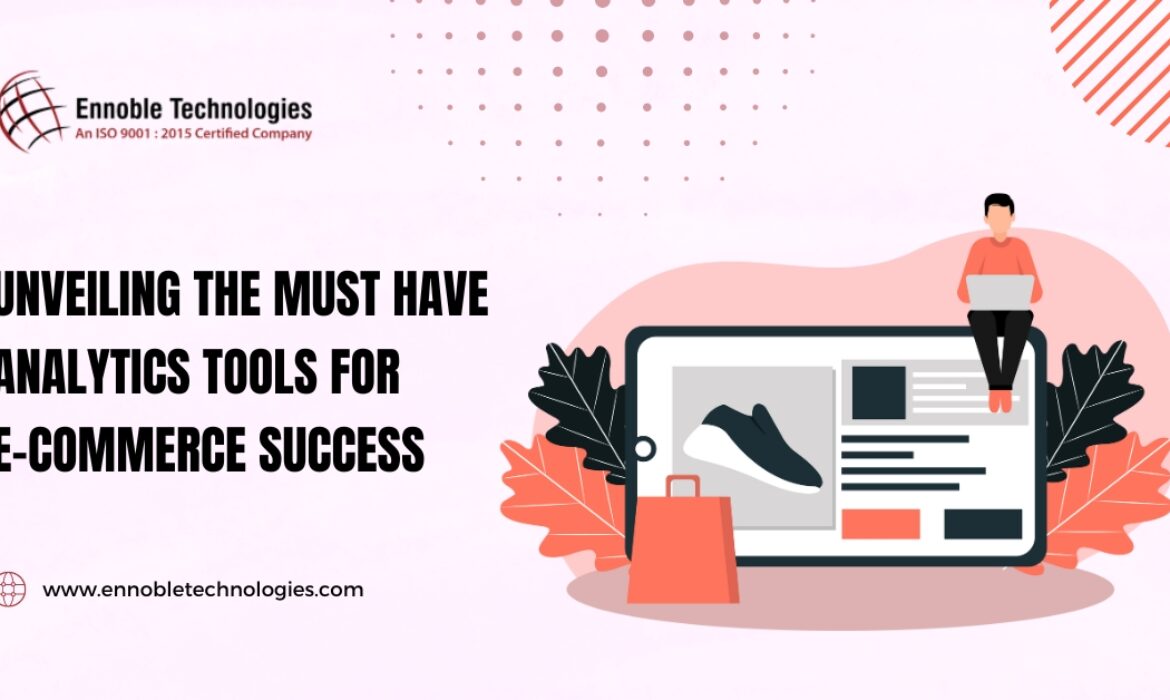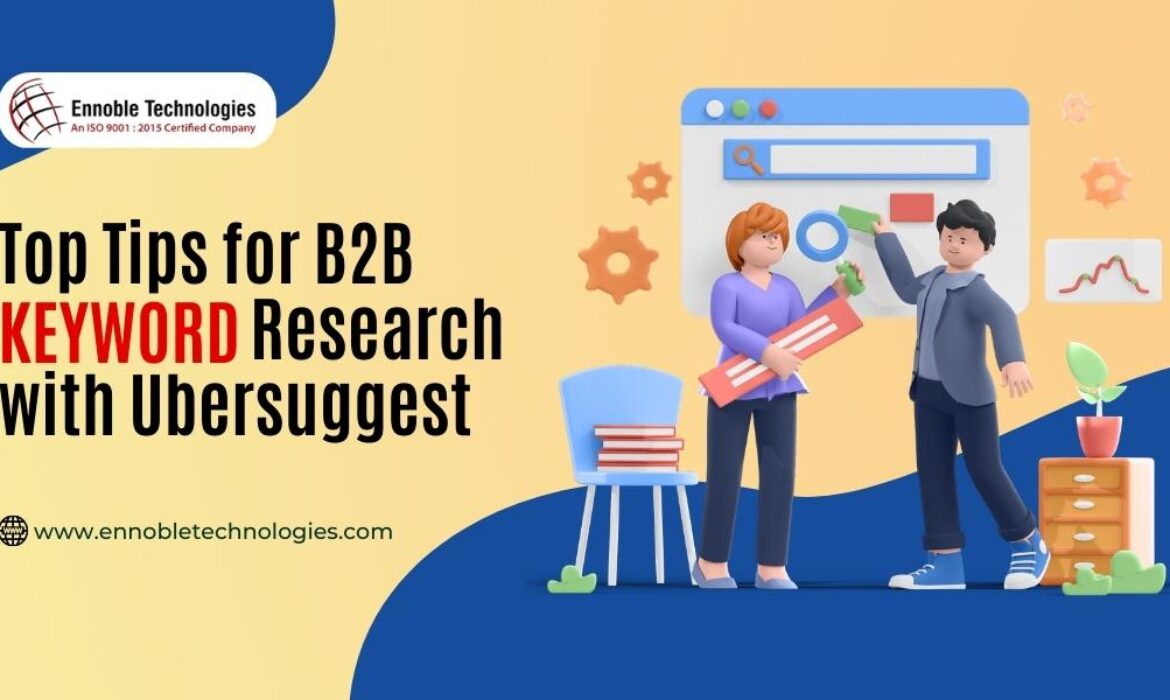Off-Page SEO Guide: Enhancing Your Business Website with Strategic Link Building for SEO Advantages
Introduction
In the world of digital marketing, Off-Page SEO plays a critical role in enhancing the visibility and ranking of websites on search engine results pages (SERPs). It focuses on optimizing factors outside the website itself, such as link building and online reputation management. Let’s delve deeper into the realm of Off-Page SEO and discover how strategic link building and other techniques can significantly impact your business’s online presence.
Understanding Off-Page SEO : A Beginner’s Guide
What is Off-Page SEO?
Off-Page SEO refers to optimization efforts that occur outside the boundaries of a website. It involves activities aimed at improving the website’s authority, relevance, and trustworthiness in the eyes of search engines. These efforts are crucial because search engines like Google consider external factors to determine a website’s credibility and rank it accordingly on SERPs.
One of the primary goals of Off-Page SEO is to acquire high-quality backlinks from reputable websites. These backlinks act as votes of confidence for your site, signaling to search engines that other sites trust your content enough to link back to it. As a result, your website’s authority and visibility increase, leading to higher rankings and organic traffic.
Importance of Off-Page SEO:
Off-Page SEO plays a pivotal role in enhancing your website’s visibility and authority on search engines. It focuses on external factors like backlinks, social signals, and brand mentions that contribute to your site’s overall reputation. By implementing effective Off-Page SEO strategies, you can improve your search engine rankings, attract organic traffic, and boost brand credibility.
Difference Between On-Page and Off-Page SEO:
On-Page SEO involves optimizing individual web pages for search engines by optimizing content, meta tags, and internal linking. In contrast, Off-Page SEO focuses on external factors such as backlinks, social media engagement, and online reputation management. While On-Page SEO is about optimizing the structure and content of your website, Off-Page SEO aims to increase your site’s authority and trustworthiness through external signals.
Types of Off-Page SEO Techniques:
a. Link Building: Acquiring quality backlinks from authoritative websites is a fundamental Off-Page SEO technique.
b. Social Media Engagement: Actively engaging with your audience on social media platforms can boost brand visibility and generate social signals.
c. Content Marketing: Creating valuable and shareable content like infographics, videos, and blog posts can attract natural backlinks.
d. Influencer Outreach: Collaborating with influencers can expand your reach and attract relevant traffic to your site.
e. Local SEO: Optimizing your online presence for local searches through local directories and Google My Business is crucial for local businesses.
Importance of Backlinks in SEO: Basics and Benefits
Backlinks are incoming hyperlinks from one webpage to another. They are a fundamental aspect of Off-Page SEO and hold significant weight in search engine algorithms. Search engines view backlinks as endorsements or votes of confidence for a website’s content. The more high-quality backlinks a site has, the more authority and credibility it gains in the eyes of search engines.
There are two main types of backlinks: Dofollow and Nofollow. Dofollow links pass link equity and contribute to a website’s SEO rankings. On the other hand, Nofollow links do not pass link equity but can still drive traffic and improve brand visibility.
Quality backlinks offer several benefits for SEO, including improved search engine rankings, increased organic traffic, enhanced online visibility, and greater trust and authority. However, it’s essential to focus on acquiring natural and relevant backlinks from authoritative sources to maximize these benefits.
Anchor Text Optimization: Beginner to Advanced Techniques
Anchor text plays a crucial role in Off-Page SEO, as it provides context and relevance to the linked content. Optimizing anchor text involves using relevant keywords or phrases that accurately describe the linked page’s content. This optimization helps search engines understand the content’s topic and improves the linked page’s ranking for those keywords.
Beginners can start by using descriptive anchor text that clearly indicates what the linked page is about. As you advance, consider using variations of anchor text, including exact match, partial match, branded, and generic anchor text. Diversifying anchor text types and incorporating long-tail keywords can enhance link relevance and improve SEO performance.
Directory Submissions Demystified: Step-by-Step Guide
Directory submissions are a common Off-Page SEO technique used to improve website visibility and generate backlinks. Directories are online platforms that categorize and list websites based on their niche or industry. Submitting your website to relevant directories can enhance its online presence and attract potential visitors and customers.
To submit your website to directories effectively, follow these steps:
- Research and identify reputable directories in your industry.
- Ensure your website meets the directory’s submission guidelines.
- Create a compelling and informative listing for your website.
- Submit your website to the selected directories, providing accurate and up-to-date information.
- Regularly monitor and update your directory listings to maintain accuracy and relevance.
By following this step-by-step guide, you can leverage directory submissions to boost your website’s visibility and attract valuable traffic.
Unlocking Off-Page SEO: Mastering Strategic Link Building for Business Growth

In today’s competitive digital landscape, Off-Page SEO plays a pivotal role in enhancing your website’s visibility and driving organic traffic. As businesses strive to optimize their online presence, understanding the nuances of Off-Page SEO becomes imperative. In this comprehensive guide, we delve into key Off-Page SEO strategies, including guest blogging, social bookmarking, harnessing social signals, influencer marketing, and PR outreach.
Guest Blogging Essentials: How to Get Started
Guest blogging is a powerful Off-Page SEO technique that not only helps in acquiring backlinks but also establishes your authority in your industry. By contributing valuable content to reputable websites, you can reach a wider audience and drive targeted traffic to your site. Here’s how to kickstart your guest blogging journey.
Introduction to Guest Blogging and its Benefits for SEO
Guest blogging involves writing and publishing content on other websites as a guest contributor. It offers several benefits for SEO, including building backlinks, increasing brand exposure, and improving search engine rankings.
How to Find Guest Blogging Opportunities in Your Niche
Start by researching websites in your niche that accept guest posts. Use search engines and social media platforms to identify potential opportunities. Look for websites with a strong domain authority and engaged audience.
Tips for Writing a Successful Guest Blog Post and Outreach Strategies
When crafting your guest blog post, focus on providing valuable, informative content that resonates with the target audience of the hosting site. Personalize your outreach emails to site owners, highlighting the value you can offer through your guest post.
Social Bookmarking Strategies: Tips for Success
Social bookmarking is another effective Off-Page SEO strategy that involves bookmarking your website or content on social bookmarking platforms. Here’s how to leverage social bookmarking for SEO benefits.
Explanation of Social Bookmarking and its Relevance in SEO
Social bookmarking platforms allow users to save, organize, and share web pages. These platforms have high domain authority, making them ideal for creating backlinks and improving website visibility.
Benefits of Social Bookmarking for Improving Website Visibility
Social bookmarking helps in generating backlinks, driving referral traffic, and increasing online visibility. It also enhances your website’s authority and credibility in the eyes of search engines.
Tips and Strategies for Effective Social Bookmarking
Choose relevant and popular social bookmarking platforms to share your content. Optimize your bookmarks with catchy titles, descriptions, and relevant keywords. Engage with other users’ bookmarks and participate in relevant communities to maximize your reach.
Harnessing Social Signals for SEO: Beginner’s Overview

Social signals refer to the metrics related to social media engagement, such as likes, shares, comments, and social media mentions. These signals can influence search engine rankings and online visibility. Here’s how to harness social signals for SEO success:
Understanding Social Signals and their Impact on Search Rankings
Social signals indicate the popularity and relevance of your content on social media platforms. Search engines consider social signals as a measure of user engagement and content quality, which can impact search rankings.
Importance of Social Signals in SEO and How They are Measured
Social signals contribute to building brand authority, driving traffic, and improving search engine visibility. Metrics like social shares, likes, comments, and follower growth are used to measure social signals’ effectiveness.
Strategies to Increase Social Signals and Monitor their Effectiveness
Create shareable and engaging content that encourages social media interactions. Use social media analytics tools to track social signals and monitor the performance of your social media campaigns. Encourage audience participation and interaction to boost social signals.
Influencer Marketing for Link Building: Getting Started Guide
Influencer marketing involves collaborating with influential individuals in your industry to promote your brand, products, or services. This strategy not only helps in building backlinks but also expands your reach and credibility. Here’s how to leverage influencer marketing for link building.
Introduction to Influencer Marketing and its Benefits for SEO
Influencer marketing allows you to tap into the existing audience of influencers and leverage their authority and credibility to promote your brand. It can result in quality backlinks, increased brand awareness, and improved search engine rankings.
How to Find and Engage with Influencers in Your Industry
Identify relevant influencers in your niche using social media platforms, influencer marketing tools, and industry directories. Build relationships with influencers by engaging with their content, offering value, and showcasing mutual benefits.
Collaborating with Influencers for Link Building and Measuring ROI
Collaborate with influencers on content creation, guest blogging, product reviews, or sponsored campaigns that include backlinks to your website. Track the performance of influencer collaborations using metrics like referral traffic, backlinks, conversions, and ROI.
PR Outreach and Press Releases: Best Practices
PR outreach and press releases are traditional yet effective Off-Page SEO tactics for gaining media coverage, building brand authority, and acquiring backlinks from reputable sources. Here’s how to execute PR outreach and press releases strategically:
Importance of PR Outreach in SEO
PR outreach helps in creating brand buzz, securing media coverage, and earning high-quality backlinks from authoritative sources. It enhances brand visibility, credibility, and trust among target audiences and search engines.
How to Write an Effective Press Release for Maximum Impact
Craft compelling press releases that are newsworthy, timely, and relevant to your target audience. Include relevant keywords, quotes, multimedia elements, and a strong call-to-action (CTA). Distribute press releases to reputable media outlets, journalists, and industry influencers.
Strategies for PR Outreach and Leveraging Press Releases for Link Building
Build relationships with journalists, bloggers, and media professionals through personalized outreach. Offer exclusive content, insights, or interviews to attract media attention. Monitor press coverage, track backlinks, and measure the impact of PR campaigns on SEO performance.
By implementing these Off-Page SEO strategies effectively, businesses can enhance their online visibility, improve search engine rankings, and drive organic traffic to their websites. Incorporate these actionable tips and best practices into your digital marketing efforts to optimize Off-Page SEO and achieve long-term success in the digital landscape.
Forum Engagement for SEO: Tips and Tricks
Engaging in forums can significantly boost your off-page SEO efforts. By actively participating in relevant forums within your industry, you can enhance your brand visibility and establish authority in your niche.
When choosing forums to engage with, prioritize those that are highly relevant to your business. Look for active communities where discussions align with your expertise and target audience.
To make the most out of forum engagement, focus on providing valuable insights and solutions to discussions. Avoid spammy or promotional posts, as these can harm your reputation and credibility.
Building rapport with other forum members is key. Respond to queries, share your knowledge, and engage in meaningful conversations to showcase your expertise.
By consistently contributing valuable content and engaging with others, you can gradually build a positive reputation and attract organic traffic to your website through forum links.
Creating Link-Worthy Infographics: Basics for Beginners

Infographics are powerful tools for link building and content marketing. They combine visual appeal with informational content, making them highly shareable and link-worthy.
When designing infographics, focus on topics that resonate with your target audience and address common pain points or interests. Use compelling visuals, statistics, and key takeaways to make your infographic informative and engaging.
To attract backlinks, consider outreach strategies such as sharing your infographic with industry influencers, bloggers, and websites that publish relevant content. Provide them with a brief summary and encourage them to link back to your infographic when they use it in their content.
Promote your infographics across social media platforms, email newsletters, and other channels to maximize exposure. Encourage sharing and make it easy for others to embed your infographic on their websites.
By creating link-worthy infographics and promoting them effectively, you can earn valuable backlinks, improve your website’s online visibility, and enhance your SEO efforts.
Building Natural Links through Relationships: Strategies for Success
Building strong relationships is essential for acquiring natural backlinks and enhancing SEO performance. Start by identifying key influencers, bloggers, and industry experts within your niche.
Networking events, conferences, and online communities are great places to connect with potential link partners. Engage with them genuinely, offer value, and show interest in their work to build meaningful relationships.
Collaborate on content projects, guest blog posts, or joint ventures to create mutually beneficial opportunities for link building. By leveraging each other’s audiences and expertise, you can attract natural backlinks and improve your search engine rankings.
Maintain regular communication with your link partners and continue to nurture relationships over time. Monitor link placements, track performance metrics, and adapt your strategies based on data insights to optimize your off-page SEO efforts.
Competitor Backlink Analysis: Tools and Insights
Analyzing your competitors’ backlinks can provide valuable insights for enhancing your own link building strategy. Start by identifying your main competitors and using SEO tools to analyze their backlink profiles.
Look for patterns in their backlink sources, anchor text usage, and link quality. Identify high-authority websites that link to your competitors, and explore opportunities to acquire similar backlinks for your site.
Utilize backlink analysis tools to assess the authority and relevance of competitor backlinks. Focus on acquiring backlinks from reputable websites within your industry to improve your own search engine rankings.
Extract insights from competitor backlinks to identify gaps and opportunities in your link building strategy. Tailor your outreach efforts, content creation, and promotional tactics based on competitive analysis to stay ahead in SEO.
Essential Off-Page SEO Tools: Must-Have Resources
Using the right tools is crucial for optimizing your off-page SEO efforts. Top off-page SEO tools offer a range of features for link building, keyword research, backlink analysis, and performance tracking.
Invest in tools that provide comprehensive link building insights, such as backlink quality assessment, competitor analysis, and link tracking capabilities. These tools help you identify link opportunities, monitor progress, and optimize your off-page SEO strategy.
Keyword research tools are essential for identifying relevant keywords, analyzing search volume, and uncovering SEO opportunities. Use backlink analysis tools to assess your backlink profile, track new links, and monitor link quality over time.
Reporting and analytics tools are critical for measuring off-page SEO success. Track key performance indicators (KPIs) like backlink growth, referral traffic, social signals, and conversion rates to evaluate the effectiveness of your SEO efforts.
Measuring Off-Page SEO Success: Key Metrics to Track
To measure the success of your off-page SEO efforts, track key metrics that reflect link building, social signals, and online visibility. These metrics provide valuable insights into your SEO performance and areas for improvement.
Key performance indicators (KPIs) for off-page SEO include:
- Backlink Quality: Monitor the quality and relevance of your backlinks, focusing on authoritative and diverse link sources.
- Social Signals: Track engagement metrics like likes, shares, comments, and mentions on social media platforms to gauge audience interaction.
- Referral Traffic: Analyze traffic from external sources to measure the impact of link building efforts on website visits.
- Conversion Rates: Measure the percentage of visitors who complete desired actions, such as signing up for newsletters or making purchases.
Using data-driven insights from these metrics, optimize your off-page SEO strategies for improved search engine rankings and online visibility.
On a final note:
Mastering off-page SEO is essential for enhancing your website’s rankings, driving organic traffic, and improving online visibility. By implementing strategic link building, leveraging digital marketing techniques, and monitoring key metrics, you can achieve SEO advantages and business growth. Follow the strategies discussed in the guide to boost your off-page SEO results and achieve online visibility optimization.
Read more: https://ennoblegrp.com/seo/mobile-optimization-for-on-page-seo/
Decoding Digital Marketing Trends: A Comprehensive Guide to Analyzing Search Engine Dominance
Introduction:
Welcome to our comprehensive guide on decoding digital marketing trends and analyzing search engine dominance. In this article, we’ll delve deep into the ever-evolving landscape of digital marketing, explore the latest trends shaping the industry, and provide actionable insights to help businesses stay ahead of the curve.
Understanding Digital Marketing Trends:
Understanding digital marketing trends is crucial for businesses looking to maintain a competitive edge in the ever-evolving digital landscape. These trends not only shape the way businesses connect with their audiences online but also influence the effectiveness of their marketing strategies.
Strategies for Decoding and Adapting:
To decode and adapt to digital marketing trends, businesses must adopt a proactive approach. This involves regularly analyzing digital marketing trends, identifying patterns and opportunities, and implementing strategic changes. By doing so, businesses can align their marketing efforts with evolving consumer behaviors and industry developments.
The future of digital marketing trends lies in data-driven decision making. With advancements in data analytics, businesses can gather actionable insights, track performance metrics, and make informed marketing decisions. By leveraging data analytics tools and techniques, businesses can optimize their marketing campaigns, identify emerging digital marketing trends, and maximize their return on investment (ROI).
The Role of Data Analytics

Understanding data analytics is paramount in today’s digital landscape. This process involves examining data sets to uncover patterns, trends, and correlations that can provide valuable insights for businesses. In the realm of digital marketing, data analytics plays a crucial role in understanding consumer behavior, evaluating campaign performance, and identifying emerging digital marketing trends.
Tools and Techniques
A plethora of data analytics tools and techniques are available to marketers, ranging from basic analytics platforms to advanced AI-driven solutions. Among these, Google Analytics stands out as a cornerstone for tracking website performance, user behavior, and digital marketing trends. Social media analytics platforms further enhance data analytics by providing insights into audience engagement, content performance, and digital marketing trends across various social platforms.
Impact on Decision-Making
The insights derived from data analytics have a profound impact on decision-making processes within businesses. By leveraging data analytics, marketers can optimize their digital marketing campaigns, refine target audience strategies, and capitalize on emerging digital marketing trends. For example, trend analysis through data analytics can reveal shifts in consumer preferences, allowing businesses to adapt their offerings accordingly.
Content Marketing Strategies
In today’s digital landscape, content marketing has emerged as a fundamental pillar of success for businesses striving to make their mark online. This section delves deep into the realm of digital marketing trends and content marketing strategies, offering insights into creating compelling content, optimizing it for search engines, and harnessing its power to bolster online visibility.
The Significance of Content Marketing
Content marketing serves as the backbone of digital marketing trends and endeavors, driving brand awareness, engagement, and conversions. By crafting valuable and relevant content aligned with digital marketing trends, businesses can establish themselves as industry leaders and connect with their target audience on a deeper level.
Creating Compelling Content
One of the key aspects of effective content marketing is creating content that resonates with your audience and aligns with digital marketing trends. This involves understanding their pain points, interests, and preferences to deliver content that provides genuine value. Strategies such as storytelling, visual elements, and multimedia content play a crucial role in capturing audience attention and fostering engagement, in line with digital marketing trends
Leveraging Content for Online Visibility
Content marketing extends beyond creating and publishing content; it also involves strategic distribution and promotion in accordance with digital marketing trends. Leveraging social media platforms, email marketing, and collaborations with influencers can significantly amplify content reach and engagement, aligning with digital marketing trends. Additionally, measuring content performance using analytics tools enables businesses to refine their strategies and achieve desired outcomes in line with digital marketing trends.
Social Media Engagement

Social media has revolutionized the way businesses connect with their audiences, making it a vital tool for building brand awareness and fostering meaningful relationships. In this chapter, we’ll explore strategies for effective social media engagement, leveraging current digital marketing trends in social media, and measuring the return on investment (ROI) of social media efforts.
Harnessing the Power of Social Media Engagement
Social media platforms offer a direct line of communication with your target audience, providing opportunities to engage, interact, and build rapport. Engaging content, timely responses, and active community participation are key ingredients for successful social media engagement. By staying updated with digital marketing trends in social media, businesses can tailor their content to resonate with their audience’s preferences and interests.
Strategies for Effective Social Media Engagement
Effective social media engagement involves more than just posting content; it requires a strategic approach. Consistency in posting, understanding audience preferences, and leveraging interactive features like polls, quizzes, and live sessions can significantly boost engagement levels. By incorporating insights from digital marketing trends, businesses can enhance their social media strategies and create content that drives meaningful interactions and conversions.
Leveraging Social Media Trends
Staying updated with the latest social media trends allows businesses to capitalize on emerging opportunities and stay ahead of the competition. Trends such as ephemeral content, influencer collaborations, and video marketing can be leveraged to create engaging and shareable content. By aligning their social media strategies with digital marketing trends, businesses can maximize their reach and engagement among their target audience.
SEO Optimization
In the ever-evolving landscape of digital marketing trends, search engine optimization (SEO) remains a cornerstone for achieving search engine dominance. In this chapter, we’ll delve into SEO best practices, effective keyword research strategies, on-page optimization techniques, and off-page SEO tactics to enhance your website’s visibility and improve search engine rankings.
Effective Keyword Research Strategies
Keyword research is the foundation of any successful SEO strategy. By identifying relevant keywords and phrases that align with user intent, businesses can optimize their content and attract targeted organic traffic. Tools like Google Keyword Planner, SEMrush, and Ahrefs can aid in keyword discovery and analysis.
On-Page Optimization Techniques
On-page optimization involves optimizing individual web pages to improve their search engine rankings and organic traffic. This includes optimizing meta tags (title tags, meta descriptions, and headers), incorporating relevant keywords naturally into content, optimizing images with alt tags, and improving overall content quality.
Off-Page SEO Tactics
Off-page SEO focuses on activities outside your website that impact search engine rankings. This includes building high-quality backlinks from reputable websites, engaging in social media promotion, participating in online communities and forums, and optimizing local SEO through directory listings and citations.
Data-Driven Decision-Making

In the era of digital marketing trends, data is the fuel that drives informed decision-making and unlocks growth opportunities. In this chapter, we’ll delve into the significance of data analytics in shaping digital marketing strategies, optimizing campaigns, and maximizing return on investment (ROI). Let’s explore how businesses can harness the power of data to make smarter, data-driven decisions.
The Power of Data Analytics
Data analytics empowers businesses to gain actionable insights from vast amounts of data, enabling them to understand customer behavior, track campaign performance, and identify emerging digital marketing trends. By leveraging advanced analytics tools and techniques, businesses can make informed decisions that drive business growth and competitive advantage.
Optimizing Marketing Campaigns
Data-driven decision-making is integral to optimizing digital marketing campaigns for maximum impact and ROI. Through data analysis, marketers can identify high-performing channels, segment audiences effectively, personalize messaging, and allocate resources strategically. This data-driven approach ensures that digital marketing efforts are targeted, relevant, and yield measurable results.
Identifying Emerging Trends
Data analytics enables businesses to stay ahead of the curve by identifying emerging digital marketing trends and market opportunities. By analyzing market trends, consumer preferences, and competitor strategies, businesses can adapt their digital marketing strategies in real time, capitalize on emerging trends, and maintain a competitive edge in the dynamic digital marketing landscape.
Emerging Technologies in Digital Marketing
In today’s rapidly evolving digital landscape, emerging technologies such as Artificial Intelligence (AI), machine learning, and automation are revolutionizing the way businesses approach marketing. In this chapter, we’ll explore the impact of these technologies on digital marketing strategies and how businesses can leverage them to stay competitive and innovative.
The Rise of AI and Machine Learning
AI and machine learning have emerged as game-changers in digital marketing trends, offering unprecedented capabilities for data analysis, personalization, and predictive insights. These technologies enable marketers to understand customer behavior, automate repetitive tasks, and deliver highly targeted and relevant content to their audiences.
Automation in Marketing Processes
Automation plays a crucial role in streamlining marketing processes, from email campaigns and social media management to lead generation and customer support. By automating repetitive tasks, businesses can free up valuable time and resources, improve efficiency, and focus on strategic initiatives that drive growth.
Personalization and Customer Experience
Emerging technologies empower businesses to deliver personalized experiences to their customers, based on data-driven insights and predictive analytics. Personalized content, recommendations, and offers enhance customer engagement, loyalty, and satisfaction, leading to increased conversions and revenue.
Optimizing Campaign Performance
AI and machine learning algorithms analyze vast amounts of data to optimize marketing campaigns in real time. From ad targeting and optimization to content performance analysis, these technologies enable marketers to make data-driven decisions that improve campaign ROI and effectiveness.
Navigating the Future of Digital Marketing
As we conclude our comprehensive guide to digital marketing trends, we shift our focus to the future of this dynamic industry. In this final chapter, we’ll explore upcoming digital marketing trends, predictions, and strategies to help businesses stay agile and adaptable in the ever-evolving digital landscape.
Trends Shaping the Future
AI-Powered Marketing: Artificial Intelligence (AI) will continue to play a pivotal role in digital marketing trends, enabling hyper-personalization, predictive analytics, and automation of routine tasks.
Voice Search Optimization: With the rise of voice assistants like Alexa and Siri, optimizing content for voice search will become imperative for businesses to maintain visibility and relevance in digital marketing trends.
Interactive Content: Interactive and immersive content formats such as AR/VR experiences, quizzes, and polls will engage audiences more effectively, driving higher levels of interaction and brand loyalty in digital marketing trends.
Video Dominance: Video content will dominate digital marketing trends on digital platforms, with short-form videos, live streaming, and interactive video ads capturing audience attention and driving engagement.
Data Privacy and Compliance: Stricter data privacy regulations and consumer concerns will necessitate transparent data practices, emphasizing trust and ethical use of customer data in digital marketing trends.
On a final note:
Decoding digital marketing trends and analyzing search engine dominance are essential for businesses looking to thrive in today’s digital landscape. By understanding these trends, leveraging data analytics, and adopting innovative strategies, businesses can enhance their online presence, reach their target audience effectively, and achieve long-term success.
Read more: https://ennoblegrp.com/social-media/power-of-youtube-marketing/
ChatGPT vs Gemini AI
In today’s rapidly evolving digital landscape, businesses are constantly seeking innovative tools and technologies to enhance their marketing strategies. Two prominent players in this domain are ChatGPT and Gemini, each offering unique capabilities and advantages. In this blog, we’ll delve into a comprehensive comparison of ChatGPT vs Gemini AI, exploring their features, applications, and suitability for various marketing tasks.
I. Introduction to ChatGPT and Gemini AI
In the realm of digital innovation, artificial intelligence (AI) has emerged as a transformative force, revolutionizing how businesses engage with customers, optimize processes, and drive growth. Two notable AI-powered solutions that have garnered significant attention in recent years are ChatGPT and Gemini. In this blog, we will delve into a comprehensive introduction to both ChatGPT and Gemini, exploring their core functionalities, applications, and potential impact on various industries.
I. Understanding ChatGPT
A. What is ChatGPT?

ChatGPT stands for “Chat Generative Pre-trained Transformer,” developed by OpenAI. It represents a breakthrough in natural language processing (NLP) technology, leveraging deep learning algorithms to understand and generate human-like text. ChatGPT is built upon the GPT architecture, which stands for “Generative Pre-trained Transformer,” a state-of-the-art model in the field of AI.
B. Core Functionalities of ChatGPT
Natural Language Understanding:
ChatGPT excels in comprehending and generating text in a manner that closely mimics human communication. It can interpret complex queries, generate coherent responses, and engage in meaningful conversations.
Content Generation:
One of ChatGPT’s primary strengths lies in its ability to generate diverse forms of content, including articles, stories, product descriptions, emails, and more. This capability streamlines content creation processes and enables businesses to scale their digital presence efficiently.
Conversational AI:
ChatGPT powers chatbots and virtual assistants with conversational intelligence, allowing them to handle customer inquiries, provide personalized recommendations, and enhance user experiences across digital platforms.
Multi-lingual Support:
ChatGPT supports multiple languages, making it a versatile solution for businesses operating in global markets. It facilitates seamless communication with diverse audiences and expands reach across linguistic barriers.
C. Applications of ChatGPT
Content Creation:
ChatGPT can generate high-quality written content, such as blog posts, social media updates, marketing materials, and website copy. This streamlines content production workflows and ensures consistency in messaging.
Customer Support:
By powering AI-driven chatbots and virtual assistants, ChatGPT enhances customer support capabilities. It can handle routine inquiries, provide instant responses, and escalate complex issues to human agents when necessary.
Personalization:
Leveraging its natural language processing capabilities, ChatGPT enables personalized interactions with users. It can analyze user preferences, tailor recommendations, and deliver targeted messaging based on individual profiles and behaviors.
Education and Training:
ChatGPT finds applications in educational settings for creating interactive learning materials, generating quiz questions, and facilitating dialogue-based learning experiences.
Evolution of ChatGPT: From GPT-3 to GPT-4
The evolution of ChatGPT from GPT-3 to GPT-4 marks a significant advancement in the field of natural language processing (NLP) and AI-driven conversational agents. Let’s delve into the key developments and improvements between these iterations
GPT-3 Overview:
- Released by OpenAI in June 2020, GPT-3 (Generative Pre-trained Transformer 3) represented a groundbreaking leap in AI language models.
- GPT-3 featured 175 billion parameters, making it one of the largest and most powerful language models at the time.
- It demonstrated exceptional capabilities in understanding and generating human-like text across a wide range of tasks, including text completion, translation, question answering, and more.
- GPT-3’s versatility and proficiency in natural language understanding made it a game-changer in various industries, including digital marketing, customer support, education, and content creation.
Advancements in GPT-4:

- GPT-4, the successor to GPT-3, introduced several key improvements and enhancements in AI language modeling.
- Parameter Increase: GPT-4 featured a significant increase in parameters, potentially surpassing the scale of GPT-3, leading to improved contextual understanding and the generation of more nuanced and coherent text.
- Enhanced Fine-Tuning Capabilities: GPT-4 offered enhanced fine-tuning capabilities, allowing developers and users to customize the model for specific tasks and domains with greater precision and efficiency.
- Improved Multimodal Capabilities: GPT-4 demonstrated improved capabilities in processing and generating multimodal content, such as text combined with images, audio, or video, enabling richer and more interactive conversational experiences.
- Enhanced Accuracy and Efficiency: GPT-4 showcased improvements in accuracy, reducing errors and ambiguities in generated text, while also optimizing computational efficiency for faster response times and lower resource requirements.
- Ethical and Bias Mitigation: GPT-4 incorporated advancements in ethical AI and bias mitigation techniques, aiming to address concerns related to fairness, inclusivity, and responsible AI deployment.
Implications and Applications:
- The evolution from GPT-3 to GPT-4 signifies a continued push towards more powerful, adaptable, and ethically conscious AI language models.
- GPT-4’s capabilities have profound implications across various sectors, including digital marketing, content creation, conversational AI interfaces, virtual assistants, healthcare, finance, and more.
- Businesses and developers can leverage GPT-4 to enhance customer interactions, automate content generation, improve decision-making processes, and drive innovation in AI-powered applications.
In conclusion, the evolution of ChatGPT from GPT-3 to GPT-4 represents a significant stride forward in AI-driven conversational AI, offering enhanced capabilities, flexibility, and ethical considerations for a wide range of applications and industries.
II. Exploring Gemini AI
A. Introduction to Gemini AI
Gemini Ai is an AI-powered platform specifically designed for digital marketing tasks. It leverages advanced machine learning algorithms to enhance various aspects of marketing campaigns, including ad optimization, content creation, and audience targeting.

B. Core Features of Gemini
Ad Optimization: Gemini Ai specializes in optimizing ad campaigns across different platforms such as Google Ads and social media channels. It can automatically adjust ad creatives, headlines, and targeting parameters to improve performance metrics like click-through rates (CTR) and conversion rates.
Content Generation: The platform helps marketers create engaging and relevant content by analyzing data trends and audience preferences. It can generate ad copies, blog posts, and social media content that resonate with target audiences, leading to higher engagement and brand visibility.
Audience Segmentation: Gemini Ai enables effective audience segmentation based on various criteria such as demographics, interests, and behavior. By segmenting audiences accurately, marketers can deliver personalized messages and offers to different customer segments, improving campaign effectiveness and ROI.
Performance Analytics: Gemini Ai provides comprehensive analytics and insights into campaign performance. It tracks key metrics, identifies trends, and offers actionable recommendations to optimize marketing strategies and achieve better results.
C. Applications of Gemini AI
Ad Campaign Optimization: Gemini Ai can optimize ad creatives, headlines, and targeting parameters to improve ad performance and ROI on platforms like Google Ads, Facebook Ads, and more.
Content Marketing: It assists in content creation by generating ad copies, blog posts, and social media content that align with audience preferences and trends.
Audience Targeting: By segmenting audiences accurately, Gemini Ai helps marketers target specific customer segments with personalized messages and offers, leading to higher conversion rates and customer satisfaction.
Overall, Gemini Ai empowers marketers with AI-driven tools and insights to streamline their digital marketing efforts, enhance audience engagement, and achieve their business goals effectively.
III. Potential Impact and Future Trends of ChatGPT and Gemini AI
Both ChatGPT and Gemini AI hold significant potential in shaping the future of digital marketing. Here’s an exploration of their potential impact and future trends:
1. ChatGPT:
- Enhanced Customer Experience: ChatGPT-powered chatbots and customer support systems can provide more personalized and human-like interactions, improving overall customer experience and satisfaction.
- Content Automation: With advancements in natural language processing (NLP), ChatGPT can automate content creation processes, generating high-quality and relevant content at scale.
- Multilingual Capabilities: As ChatGPT continues to evolve, its multilingual support will enable businesses to reach global audiences more effectively, breaking language barriers in digital marketing.
- Ethical Considerations: The future of ChatGPT also involves addressing ethical concerns related to AI, such as bias mitigation, data privacy, and transparency in AI-generated content.
2. Gemini AI:
- AI-Driven Optimization: Gemini’s AI-driven optimization capabilities will become more sophisticated, offering marketers real-time insights and recommendations to improve ad performance and content engagement.
- Predictive Analytics: The platform may incorporate predictive analytics models to forecast trends, customer behavior, and campaign outcomes, enabling proactive decision-making in marketing strategies.
- Integration with IoT and Data Sources: Gemini Ai could integrate with Internet of Things (IoT) devices and diverse data sources to gather comprehensive customer insights, leading to more targeted and personalized marketing campaigns.
- AI Ethics and Compliance: Similar to ChatGPT, Gemini AI will likely focus on AI ethics and compliance standards to ensure responsible use of AI in digital marketing practices.
Future Trends:
- AI-Powered Creativity: Both ChatGPT and Gemini AI will contribute to AI-powered creativity, where AI algorithms assist human marketers in ideation, content creation, and campaign optimization, fostering innovation and efficiency.
- Hyper-Personalization: The future trend of hyper-personalization will see AI tools like ChatGPT and Gemini Ai deliver highly customized experiences to individual customers, based on their preferences, behavior, and real-time interactions.
- AI-Driven Insights: AI-driven insights and analytics will play a crucial role in refining marketing strategies, identifying new opportunities, and predicting market trends, empowering businesses to stay competitive in dynamic markets.
- Collaborative AI Ecosystem: A collaborative AI ecosystem may emerge, where ChatGPT, Gemini Ai, and other AI tools seamlessly integrate to offer end-to-end solutions for marketers, from content creation to campaign optimization and performance tracking.
In conclusion, ChatGPT and Gemini AI represent the forefront of AI innovation in digital marketing, with the potential to drive transformative changes in customer experiences, content strategies, and campaign performance. Embracing these technologies while addressing ethical considerations will be key to harnessing their full potential and staying ahead in the evolving landscape of digital marketing.
ChatGPT vs Gemini AI
| Feature | ChatGPT | Gemini AI |
| Developer | OpenAI | Google AI |
| Focus | General-purpose NLP | Digital Marketing |
| Core Functionalities | – Natural Language Understanding – Content Generation – Conversational AI – Multi-lingual Support | – Ad Optimization – Content Generation – Audience Segmentation – Performance Analytics |
| Strengths | – Wide range of applications – Human-like text generation – Multilingual capabilities | – Optimized for marketing tasks – Data-driven audience insights – Performance tracking and recommendations |
| Applications | – Content creation – Customer support – Personalization – Education and Training | – Ad campaign optimization – Content marketing – Audience targeting – Marketing analytics |
| Evolution | – GPT-3 (2020) to GPT-4 (future) | – Ongoing development |
| Focus of Evolution | – Increased parameters – Enhanced fine-tuning – Improved accuracy and efficiency – Ethical and bias mitigation | – Advanced AI-driven optimization – Predictive analytics – Integration with diverse data sources |
| Potential Impact | – Personalized customer experiences – Content automation – Multilingual marketing reach | – AI-driven marketing optimization – Hyper-personalized campaigns – Data-driven insights for decision-making |
Additional Notes:
- ChatGPT excels in general-purpose NLP tasks, while Gemini is specifically designed for marketing applications.
- Both platforms are evolving rapidly, with a focus on improving capabilities and addressing ethical considerations.
- The future of AI in marketing likely involves a collaborative ecosystem where different tools work together seamlessly.
Advantages and Limitations
ChatGPT
Advantages:
- Efficiency: ChatGPT accelerates content creation processes, saving time and resources.
- Versatility: It can generate content across various formats and industries.
- Consistency: Maintains a consistent tone and style throughout generated content.
- Scalability: Scales seamlessly to meet increased content demands.
- SEO Optimization: Optimizes content for search engines, improving visibility.
- Cost-Effectiveness: Reduces labor costs associated with manual content creation.
- Creativity: Inspires creative ideas and offers suggestions for content generation.
- Data-Driven Insights: Provides insights into content performance and audience preferences.
Limitations:
- Quality Control: Requires manual review to ensure generated content meets quality standards.
- Contextual Understanding: May lack nuanced contextual understanding in certain niche topics.
- Bias and Errors: Can produce biased or inaccurate content based on input data.
- Human Touch: Some content may still require human input for authenticity and originality.
- Learning Curve: Users may need time to learn optimal use and customization of the tool.
- Privacy Concerns: Data privacy and security concerns may arise with sensitive content.
- Language Limitations: Limited support for languages outside major ones, affecting global reach.
- Over-Reliance Risk: Over-reliance on AI-generated content without human input can lead to generic or repetitive content.
Gemini AI
Advantages:
- Trading Optimization: Enhances trading strategies and risk management for investors.
- Market Analysis: Provides real-time market analysis, trends, and investment insights.
- Personalization: Offers personalized investment recommendations based on user preferences.
- Portfolio Management: Helps users optimize and manage their investment portfolios.
- Automation: Supports automated trading strategies and execution for efficiency.
- Security: Operates within a secure platform with robust security measures.
- User-Friendly Interface: Offers an intuitive interface for traders of all levels.
- Transparency: Provides transparent information on market data, pricing, and transactions.
Limitations:
- Learning Curve: Users may require knowledge of trading and investment concepts.
- Risk Factors: Involves financial risk, and users should exercise caution and due diligence.
- Market Volatility: Vulnerable to market fluctuations and volatility, impacting investment outcomes.
- Regulatory Compliance: Subject to regulatory changes and compliance requirements.
- Data Security: Risks associated with data breaches and cyber threats in the cryptocurrency space.
- Limited Predictability: Market predictions and forecasts may not always be accurate.
- Liquidity Issues: Some cryptocurrencies may have liquidity constraints, affecting trading options.
- Technical Issues: Potential for technical glitches, downtime, or platform disruptions affecting trading experience.
These advantages and limitations highlight the diverse capabilities and considerations associated with ChatGPT for content creation and Gemini AI for cryptocurrency trading, emphasizing the need for strategic usage, risk management, and ongoing evaluation of these technologies in their respective domains.
Brief overview of AI-driven content generation

AI-driven content generation refers to the process of using artificial intelligence (AI) technologies to create, curate, and optimize digital content. This innovative approach leverages machine learning algorithms to understand human language patterns, analyze data, and generate high-quality content across various formats such as articles, blog posts, social media updates, product descriptions, and more.
The evolution of AI-driven content generation has been significant, with advancements in natural language processing (NLP) leading to the development of sophisticated AI models like OpenAI’s GPT (Generative Pre-trained Transformer) series, including GPT-3 and GPT-4. These models are trained on vast datasets and can generate human-like text based on the input they receive.
Businesses and content creators are increasingly adopting AI-driven content generation tools due to several benefits they offer:
- Efficiency: AI can generate content at scale and speed, reducing the time and effort required for manual content creation.
- Consistency: AI ensures consistency in tone, style, and messaging across various pieces of content.
- Personalization: AI can analyze user data and preferences to create personalized content tailored to individual users or audience segments.
- SEO Optimization: AI-powered tools can optimize content for search engines, improving visibility and organic reach.
- Cost-Effectiveness: Automated content generation can lower production costs compared to traditional methods.
Overall, AI-driven content generation empowers businesses to streamline their content creation processes, improve content quality, and engage with their target audience more effectively in today’s digital landscape.
Comparison of ChatGPT vs Gemini AI

1. Purpose and Usage
ChatGPT:
- Purpose: ChatGPT is primarily designed for natural language processing (NLP) tasks, including text generation, conversation generation, content creation, language translation, sentiment analysis, and more.
- Usage: It is widely used in digital marketing, customer support, content generation, chatbots, virtual assistants, educational tools, and various AI-driven applications requiring human-like text generation and understanding.
Gemini AI:
- Purpose: Gemini AI is a subset of Gemini cryptocurrency exchange’s technology, focused on optimizing trading strategies, risk management, market analysis, and providing personalized investment recommendations.
- Usage: It is specifically used within the Gemini platform for cryptocurrency trading, investment management, portfolio optimization, price prediction, and enhancing user experience in the financial markets.
2. Technology and Algorithms
ChatGPT:
- Technology: ChatGPT is based on transformer architecture, leveraging deep learning techniques, attention mechanisms, and large-scale pre-training on diverse text data.
- Algorithms: It employs language modeling algorithms, fine-tuning mechanisms, tokenization, and generation strategies to produce coherent and contextually relevant text responses.
Gemini AI:
- Technology: Gemini AI utilizes machine learning algorithms, statistical modeling, data analysis, and blockchain technology within the Gemini cryptocurrency exchange platform.
- Algorithms: It employs trading algorithms, risk assessment models, trend analysis, sentiment analysis, price forecasting algorithms, and machine learning-based strategies to optimize trading outcomes and enhance user profitability.
3. User Experience
ChatGPT:
- User Interface: ChatGPT typically offers a user-friendly interface through API integration, web-based platforms, chat interfaces, or developer SDKs.
- User Interaction: Users interact with ChatGPT by providing prompts, queries, or input text, and receiving AI-generated responses or content recommendations.
Gemini AI:
- User Interface: Gemini AI is integrated within the Gemini exchange platform, offering a seamless trading experience with intuitive dashboards, real-time market data, trading tools, and portfolio management features.
- User Interaction: Users engage with Gemini AI by accessing trading insights, market analysis, investment suggestions, risk assessments, and automated trading strategies within the Gemini ecosystem.
4. Security and Privacy
ChatGPT:
- Security: ChatGPT platforms prioritize data security, encryption standards, access controls, and compliance with privacy regulations to protect user information and content.
- Privacy: They adhere to privacy policies, data anonymization practices, user consent mechanisms, and transparency regarding data usage and storage.
Gemini AI:
- Security: Gemini AI operates within the secure infrastructure of the Gemini exchange, implementing robust security measures, multifactor authentication, cold storage for assets, and continuous monitoring for threats.
- Privacy: It upholds user privacy through encrypted communication channels, privacy-enhancing technologies, data minimization principles, and compliance with financial regulations governing user data protection.
Comparison of ChatGPT and Gemini AI
| Feature | ChatGPT | Gemini AI |
| Purpose and Usage | – General-purpose NLP tasks (text generation, conversation, content creation, translation) – Customer support, content marketing, chatbots, education | – Digital marketing optimization (ad optimization, content creation, audience segmentation) – Social media marketing, content marketing, campaign management |
| Technology and Algorithms | – Transformer architecture, deep learning, attention mechanisms – Language modeling, fine-tuning, tokenization | – Machine learning algorithms, data analysis, marketing automation – A/B testing, audience segmentation models, content optimization algorithms |
| User Experience | – API integration, web platforms, chat interfaces – Text prompts, query-based interaction | – Marketing dashboards, reporting tools, content creation workflows – Campaign management interfaces, audience targeting features |
| Security and Privacy | – Data encryption, access controls, privacy regulations – User consent, data anonymization | – Secure exchange infrastructure, multifactor authentication, cold storage – Financial data protection regulations |
In summary, while both ChatGPT and Gemini AI harness advanced technologies and algorithms, they serve distinct purposes in NLP and Ad optimization, respectively. Their differences in user experience, technology stacks, and security measures align with their specific domains of application, catering to diverse user needs and objectives.
Read more : Unlocking the Power of YouTube Marketing: Key Benefits for Your Business
E-E-A-T Unveiled: Elevating Your Online Presence with Expertise, Authoritativeness, and Trustworthiness
Understanding E-A-T
What is E-A-T?
E-A-T stands for Expertise, Authoritativeness, and Trustworthiness. Expertise refers to the depth of knowledge and skill in a particular subject. Authoritativeness pertains to being recognized as a credible and influential source within a specific industry or field. Trustworthiness involves establishing reliability, transparency, and integrity to gain the trust of users.
Search engines prioritize websites that exhibit high levels of E-A-T as they aim to deliver the most relevant and trustworthy results to users. Websites with strong E-A-T are perceived as reliable sources of information, which leads to higher search engine rankings and increased visibility.
Websites like Mayo Clinic (Expertise), Harvard Business Review (Authoritativeness), and Consumer Reports (Trustworthiness) are excellent examples of entities that excel in one or more aspects of E-A-T. These websites consistently produce high-quality, credible content that resonates with their target audience, thus establishing themselves as authoritative sources in their respective fields.
The Role of E-A-T in SEO
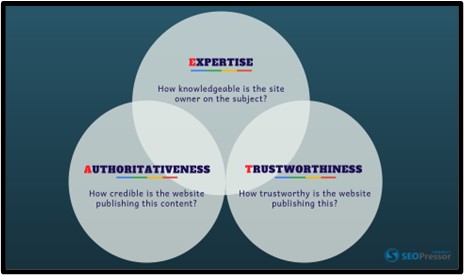
Search engines assess E-A-T through various factors, including content quality, backlink profile, user experience, and website reputation. Algorithms analyze signals such as expertise demonstrated by content creators, endorsements from authoritative sources, and user feedback to gauge the trustworthiness and credibility of a website.
Google’s E-A-T update, which rolled out in 2018, placed greater emphasis on the quality and expertise of content, particularly in the health and finance niches. Websites that failed to demonstrate expertise, authoritativeness, and trustworthiness saw a decline in their search visibility, highlighting the importance of aligning with E-A-T guidelines.
Websites that prioritize E-A-T principles often experience improved search rankings and visibility. By consistently delivering valuable, authoritative content and fostering trust with users, these websites attract more organic traffic and earn higher rankings in search engine results pages (SERPs).
—————————————————————————————————————————————————————–
Demystifying E-E-A-T: A Timeline and Deep Dive
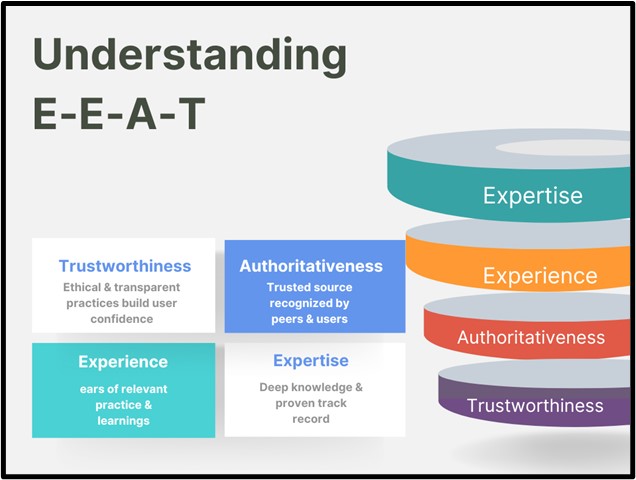
E-E-A-T, short for Expertise, Experience, Authoritativeness, and Trustworthiness, has become a crucial factor in Google’s search algorithm, impacting website rankings and user trust. Let’s delve into its history, evolution, and key aspects through a comprehensive timeline:
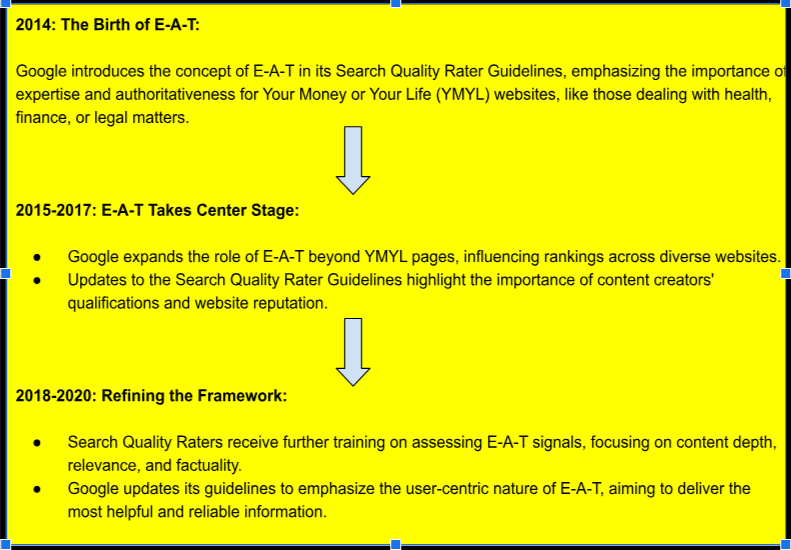
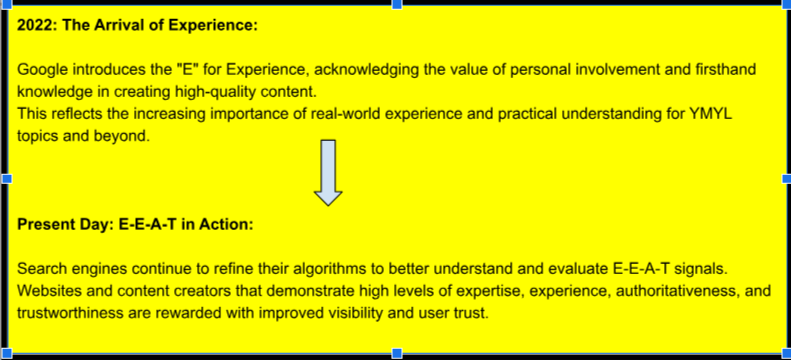
Key Points to Remember:
- E-E-A-T is an ongoing effort, not a one-time achievement.
- There are no shortcuts for building E-E-A-T; consistent focus on quality and user-centricity is paramount.
- E-E-A-T applies to all websites, regardless of industry or niche.
- Google’s search algorithm evolves continuously, so staying updated on best practices is crucial.
- Beyond the Timeline.
FAQs
Q: Who drives E-E-A-T?
A: Google Search Quality Raters, a global team of human experts, evaluate websites and content based on E-E-A-T principles.
Q: How does E-E-A-T impact search results?
A: Websites with high E-E-A-T tend to rank higher in relevant searches, as Google prioritizes content deemed trustworthy and helpful.
Q: What are the benefits of high E-E-A-T?
A: Increased website traffic, improved user engagement, stronger brand reputation, and potentially higher conversion rates.
By understanding the origins, evolution, and key aspects of E-E-A-T, you can develop a strategic approach to create content and build a website that resonates with both users and search engines. Remember, the journey towards high E-E-A-T is a continuous pursuit of excellence, focused on delivering valuable information and building genuine trust with your audience.
Exploring the Four Pillars of EEAT:
- Expertise
- Experience
- Authoritativeness
- Trustworthiness
Expertise: Establishing Content Authority
Showcasing Expertise Through Content
- Conduct thorough research on relevant topics.
- Provide original insights and analysis.
- Offer comprehensive coverage of content.
In-depth research ensures the accuracy and credibility of your content, while original insights and comprehensive coverage demonstrate your expertise and thought leadership in your field.
- Identify trending topics within your niche.
- Address common pain points or questions from your target audience.
- Leverage keyword research to uncover topics with high search demand.
Demonstrating Expertise: A Table of Strategies
| Aspect of Expertise | Strategies | Examples |
| Qualifications | * Highlight relevant educational degrees, certifications, or professional licenses. * Mention awards or recognitions received in your field. * Showcase membership in professional organizations or associations. | * “Dr. Sarah Jones, a board-certified dermatologist with 15 years of experience…” * “Winner of the 2023 ‘Best Technology Blog’ award.” * “Member of the American Marketing Association.” |
| Experience | * Describe your professional background and relevant past projects. * Share case studies or success stories demonstrating expertise in action. * Quantify your experience with years, numbers, or specific achievements. | * “Led a team of engineers to develop a new software application used by over 1 million people.” * “Increased website traffic by 300% through SEO optimization strategies.” * “10+ years of experience in writing and editing technical content.” |
| Achievements | * Share published articles, research papers, or books you’ve authored. * Mention speaking engagements or presentations you’ve delivered. * Highlight notable contributions you’ve made to your field. | * “Author of the best-selling book ‘The Art of Persuasive Writing’.” * “Featured speaker at the International Marketing Conference.” * “Developed a new training program for customer service representatives that resulted in a 20% increase in customer satisfaction.” |
| Content & Communication | * Craft high-quality content that is accurate, informative, and well-researched. * Use clear, concise language and avoid jargon when possible. * Respond to comments and questions thoughtfully and professionally. | * Cite credible sources to support your claims. * Use visuals, data, and examples to enhance understanding. * Engage in respectful discussions and offer alternative perspectives. |
| Thought Leadership | * Share your expertise through blog posts, articles, or social media. * Offer insights and opinions on current trends and issues in your field. * Participate in online communities and forums related to your area of expertise. | * Write guest posts for industry publications. * Start a podcast or YouTube channel to share your knowledge. * Host webinars or online workshops on relevant topics. |
Experts in Digital Marketing: A Diverse Landscape
| Field | Individuals | Organizations |
| SEO | Rand Fishkin (Moz), Bill Slawski, Aleyda Solis, Barry Schwartz, Marie Haynes | Moz, Search Engine Land, SEMrush, Backlinko, Ahrefs |
| Content Marketing | Neil Patel (Neil Patel Digital), Ann Handley (MarketingProfs), Joe Pulizzi, Andy Crestodina, Jay Baer (Convince & Convert) | Content Marketing Institute, Copyblogger, BuzzSumo, HubSpot Academy, Content Marketing Mastery |
| Social Media Marketing | Kim Garst, Ian Cleary (RazorSocial), Mari Smith, Amy Porterfield, Gary Vaynerchuk | Social Media Examiner, Hootsuite, Sprout Social, Buffer, Socialbakers |
| Paid Advertising | Frederick Vallaeys, Larry Kim (MobileMonkey), Brad Geddes, Perry Marshall, Charles Ngo | WordStream, PPC Hero, Unbounce, The SEM Agency, KlientBoost |
| Analytics & Data-Driven Marketing | Avinash Kaushik, Simon Kemp, Greg McKeown, Cindy Krum, RJ Metrics | Google Analytics Academy, Mixpanel, Looker, Tableau, Amplitude |
Experience
While expertise, authoritativeness, and trustworthiness are well-established pillars of E-E-A-T, the recent addition of “experience” brings a fresh perspective to this framework. Let’s delve into what experience signifies and how it impacts your online presence:
Experience: More Than Just Years
Experience goes beyond mere years in the field. It encompasses:
- Firsthand knowledge: Having actively engaged in the subject matter, not just studying it theoretically.
- Practical understanding: Applying your knowledge to solve real-world problems and challenges.
- Proven track record: Demonstrating successes and achievements through case studies, testimonials, or portfolio showcases.
- Direct interactions: Engaging with the audience, understanding their needs, and providing relevant solutions.
Why Experience Matters:
- Enhanced credibility: Personal experience adds depth and authenticity to your content, making it more relatable and believable.
- Sharpened insights: Real-world experience helps you identify pain points, anticipate user needs, and offer valuable solutions.
- Improved content quality: Practical knowledge translates into content that is grounded, informative, and actionable.
- Stronger audience connection: Sharing your experiences fosters empathy and builds trust with your audience.
—————————————————————————————————————————————————————–
Building Your E: My Evolution in Digital Marketing: From Scratch to Heights (A 10+ Year Journey)
My journey in digital marketing began over a decade ago, fueled by a fascination with the power of the internet to connect and influence. Starting with basic HTML and SEO knowledge gleaned from online tutorials, I embarked on a self-taught path that would lead me through the trenches of both white hat and black hat practices, ultimately shaping the ethical and data-driven marketer I am today.
Early Days: Experimentation and Exploration:
My first foray was building websites for friends and local businesses, learning the ropes of design, development, and basic SEO.
Curiosity led me to explore the “dark side” of SEO – keyword stuffing, link farms, and other black hat techniques. While initially successful, I quickly realized the ethical and long-term sustainability issues involved.
Learning and Evolving:
This experience sparked a deep dive into ethical and sustainable digital marketing practices. I devoured books, blogs, and online courses, soaking up knowledge from industry authorities.
Joining online communities and forums connected me with other passionate marketers, fostering valuable learning and collaboration.
Putting Theory into Practice:
Equipped with newfound knowledge, I started freelancing, offering SEO, content marketing, and social media management services.
Working with diverse clients across industries honed my skills and adaptability, allowing me to tackle unique challenges and achieve tangible results.
Climbing the Ladder:
Joining a small digital marketing agency provided invaluable experience in team dynamics, client management, and campaign strategy development.
Contributing to successful campaigns for major brands solidified my understanding of data-driven decision-making and the importance of measuring impact.
Reaching New Heights:
Today, I find myself at the forefront of the digital marketing landscape, leading a team of talented individuals.
We focus on crafting data-driven, user-centric strategies that deliver results while adhering to ethical and sustainable practices.
My journey has been a continuous learning process, fueled by a passion for innovation and a commitment to building trust with both users and clients.
—————————————————————————————————————————————————————–
Authoritativeness: Becoming a Trusted Source
What Makes a Source Authoritative?
In the digital age, discerning reliable information from noise requires understanding what makes a source authoritative. This goes beyond just a name or label; it’s a combination of factors that build trust and credibility. Here are the key elements:
Key Elements of an Authoritative Source:
Recognition: | Recognition | Score | —|—
- Established reputation | 8/10 |
- Affiliation with prestigious institutions | 7/10 |
- Awards and accolades | 6/10 |
- Industry endorsements | 5/10 |
Recognition reflects the source’s standing within its field. A well-established research institute naturally carries more weight than a personal blog. Awards and affiliations further solidify recognition, but they’re not the sole indicators.
Reputation: | Reputation | Score | —|—
- Transparency in methodology and data sources | 8/10 |
- Accuracy and factuality of information | 8/10 |
- Lack of bias or conflicts of interest | 7/10 |
- Positive feedback from experts and users | 6/10 |
Reputation hinges on the source’s commitment to truth and objectivity. Transparency allows users to evaluate the information’s foundation, while factual accuracy is paramount. Minimizing bias and garnering positive feedback from trusted individuals further strengthens reputation.
Influence: | Influence | Score | —|—
- Reach and engagement with target audience | 7/10 |
- Impact on shaping opinions and discussions | 6/10 |
- Frequency of citations by other reputable sources | 5/10 |
- Trusted by key decision-makers and experts | 5/10 |
Influence reflects the source’s ability to shape the conversation and reach the intended audience. High engagement and reach indicate a substantial following, while citation frequency shows how other experts value the source’s information. Influence also extends to shaping opinions and being trusted by decision-makers.
Establishing Authoritative Backlinks
Backlinks from reputable websites serve as endorsements of your content and contribute to your website’s authority and credibility.
- Create valuable, link-worthy content.
- Outreach to relevant websites or influencers in your niche.
- Participate in industry events or collaborations.
Avoid manipulative link-building practices such as buying links or participating in link schemes, as they can result in penalties from search engines and damage your website’s reputation.
Optimizing Website Structure and Navigation
- Use clear and descriptive headings.
- Implement a hierarchical site structure.
- Include breadcrumbs for easy navigation.
Clear navigation menus and breadcrumbs help users navigate your website easily, while internal linking improves crawlability and helps search engines discover and index your content. Optimizing meta tags, headings, and URL structures with relevant keywords can improve your website’s visibility in search results and attract more organic traffic.
Consistency Across Platforms
Consistency in branding and messaging helps reinforce your brand identity and build trust with your audience across different platforms.
Ensure that your social media profiles, business listings, and other online assets reflect your brand’s identity and values consistently.
Regularly monitor online reviews and feedback from customers, and respond promptly to address any concerns or issues. Positive reviews and testimonials can enhance your reputation and credibility.
Trustworthiness: Building Customer Confidence
Building Trust: Key Factors and Visual Representation
Trust is the cornerstone of any successful interaction, be it personal or online. In the digital world, where information overload and potential deception lurk around every corner, building trust is crucial for websites, brands, and individuals. Here are the key factors that contribute to trustworthiness, visualized in a bar graph:
Key Factors Building Trust:
Transparency: | Transparency | Score | —|—
- Clear communication of policies and practices | 8/10 |
- Easy access to information about the team or organization | 7/10 |
- Honest disclosure of potential biases or limitations | 6/10 |
- Willingness to engage in open communication and feedback | 5/10 |
Transparency fosters trust by allowing users to understand who they’re interacting with, how their data is used, and what to expect. Clear communication, open access to information, and a willingness to address concerns are key components.
Ethics: | Ethics | Score | —|—
- Commitment to ethical data collection and usage practices | 8/10 |
- Respect for user privacy and security | 7/10 |
- Avoidance of misleading or deceptive information or practices | 6/10 |
- Alignment with ethical principles relevant to the field | 5/10 |
Ethical behavior builds trust by demonstrating respect for users and their data. Responsible data handling, honest information, and adherence to relevant ethical guidelines are essential.
Data Privacy: | Data Privacy | Score | —|—
- Strong data security measures to protect user information | 8/10 |
- Clear and understandable data privacy policies | 7/10 |
- User control over data collection and usage practices | 6/10 |
- Respect for user preferences regarding data sharing and marketing | 5/10 |
Data privacy plays a crucial role in building trust. Robust security measures, clear policies, user control over data, and respecting preferences show commitment to protecting user information.
Competence: | Competence | Score | —|—
- Demonstrated expertise and knowledge in the relevant field | 8/10 |
- Ability to deliver on promises and commitments | 7/10 |
- Consistent delivery of high-quality content or services | 6/10 |
- Willingness to learn and adapt to changing needs and challenges | 5/10 |
Competence builds trust by demonstrating the ability to provide value. Expertise, reliability, consistent quality, and a commitment to learning show that users can rely on the individual or organization.
Authenticity: | Authenticity | Score | —|—
- Genuine and relatable presentation of oneself or organization | 8/10 |
- Openness and vulnerability in communication | 7/10 |
- Consistency between online and offline personas or values | 6/10 |
- Active engagement in building genuine connections with users | 5/10 |
Authenticity fosters trust by creating a sense of connection and genuine interaction. Being relatable, open, consistent, and actively engaging with users demonstrates a genuine desire to build trust.
Transparency and Authenticity
Transparency builds trust with your audience and demonstrates integrity in your business practices.
Authenticity humanizes your brand and fosters a deeper connection with your audience. Share behind-the-scenes content, feature user-generated content, and highlight your team to showcase the people behind your brand.
Encourage customers to leave honest reviews and testimonials, and showcase positive feedback and success stories to build trust with potential customers.
Secure Website Infrastructure
A secure website infrastructure protects user data and instills confidence in your audience. Implement security measures to safeguard sensitive information and mitigate cybersecurity risks.
Comply with data protection regulations and implement measures to secure customer data, such as encryption and access controls.
Display trust badges and security seals prominently on your website to reassure visitors that their information is safe and secure.
Customer Support and Engagement
Responsive customer support builds trust and confidence in your brand. Provide multiple channels for customers to reach out for assistance and ensure timely responses to inquiries.
Engage with your audience on social media, through email newsletters, and in online communities to foster relationships and build trust over time.
User-generated content and customer testimonials provide social proof of your product or service’s value and help build trust with potential customers.
Research, Data Analysis, and Critical Thinking in Digital Marketing: Building E-E-A-T
In the realm of digital marketing, where competition is fierce and audience attention fleeting, building expertise and establishing E-E-A-T (Expertise, Authoritativeness, and Trustworthiness) is crucial for success. Research, data analysis, and critical thinking are not just valuable skills; they are essential tools for any digital marketer seeking to build a strong online presence and achieve sustainable results.
Research:
- Market research: Analyze your target audience, their demographics, online behavior, and pain points. This helps you tailor your messaging, content strategy, and campaign targeting for maximum impact.
- Competitor analysis: Identify your competitors’ strengths and weaknesses, their content strategies, and their performance in search results. This allows you to develop differentiated strategies and optimize your approach
- Industry trends: Stay up-to-date with the latest trends in digital marketing, algorithm updates, and emerging technologies. This helps you adapt your strategies to changing landscapes and maintain a competitive edge.
Data Analysis:
- Website analytics: Analyze website traffic data to understand user behavior, identify high-performing content, and measure the effectiveness of your campaigns. This helps you optimize your website for user experience and conversions.
- Social media analytics: Analyze your social media engagement, audience demographics, and content performance. This helps you refine your social media strategy and tailor it to resonate with your target audience.
- Campaign performance: Analyze the performance of your paid advertising campaigns, including click-through rates, conversion rates, and return on investment. This helps you optimize your campaigns and make informed decisions about resource allocation.
Critical Thinking:
- Evaluating content quality: Critically evaluate your own content and that of your competitors. Ask yourself: Is it accurate, informative, and engaging? Does it address user needs and provide value?
- Identifying biases: Be aware of your own biases and those present in the information you consume. This helps you make objective decisions and avoid perpetuating misleading or harmful content.
- Experiment and test: Don’t be afraid to experiment with new strategies and tactics. Analyze the results critically and adapt your approach based on what works and what doesn’t.
By actively engaging in these practices, digital marketers can:
- Demonstrate expertise: Their research and data analysis provide evidence of their knowledge and understanding of the digital landscape.
- Boost authoritativeness: Their ability to critically evaluate information and identify high-quality sources builds trust and confidence in their expertise.
- Increase trustworthiness: Their data-driven approach and focus on user needs demonstrate transparency and reliability, enhancing their E-E-A-T in the eyes of both users and search engines.
Remember, building E-E-A-T in digital marketing is an ongoing process. By continuously honing your research, data analysis, and critical thinking skills, you can create high-quality content, make informed decisions, and establish yourself as a trusted authority in your field, ultimately achieving lasting success in the ever-evolving digital landscape.
—————————————————————————————————————————————————————–
The Impact of EEAT:
E-E-A-T, standing for Expertise, Authoritativeness, and Trustworthiness, has become a crucial factor in both the online world and Google’s search algorithms. Its impact extends beyond just website ranking, influencing audience perception and brand reputation in significant ways. Let’s delve deeper into how E-E-A-T plays this multifaceted role:
| Area Impacted | How E-E-A-T Influences It | Examples |
| Website Ranking | * Google prioritizes reliable and informative content. * Websites with strong E-E-A-T signals rank higher, especially for YMYL topics. * Backlinks from authoritative sources boost E-E-A-T. | * Medical website with clear information and citations from reputable medical journals. * Financial advisor website with transparent fee structure and client testimonials. * Legal website with team bios showcasing relevant expertise and awards. |
| Audience Perception | * Strong E-E-A-T builds trust and credibility. * Transparency and clarity foster positive perception. * Website becomes a go-to resource for reliable information. | * Informative blog posts with expert author bios and verifiable data sources. * Responsive customer service addressing user queries promptly and professionally. * Regularly updated content demonstrating commitment to providing fresh information. |
| Brand Reputation | * Strong E-E-A-T leads to a positive brand image. * E-E-A-T serves as a differentiator in a competitive landscape. * Helps mitigate negative impacts on brand reputation during challenging situations. | * E-commerce website with secure payment processing and clear return policy. * Sustainability-focused clothing brand showcasing ethical production practices. * Company website with clear mission statement and commitment to social responsibility. |
The Pitfalls of Low E-E-A-T: Visibility Dwindles, Trust Erodes
In today’s digital landscape, where information overload reigns supreme, establishing Expertise, Authoritativeness, and Trustworthiness (E-E-A-T) is no longer optional; it’s essential for survival. Conversely, low E-E-A-T can have significant consequences, impacting everything from website visibility to brand reputation.
Let’s delve into the potential pitfalls and provide real-life examples:
Decreased Visibility:
- Search engine algorithms: Google prioritizes websites with strong E-E-A-T signals, pushing those lacking in expertise or trustworthiness further down the search results page. This translates to fewer organic website visits, potentially impacting brand awareness and lead generation.
- Example: A health blog with inaccurate medical information and a lack of author credentials may experience a drop in search ranking compared to a website with qualified medical professionals and evidence-based content.
Lost Credibility and User Engagement:
- Erosion of trust: Users are increasingly discerning; they can quickly identify websites with low E-E-A-T due to factors like misleading information, spammy content, or lack of transparency. This leads to a loss of trust and user engagement, hindering conversion rates and brand loyalty
- Example: A social media influencer promoting questionable health products without proper research or disclosure of sponsorships might see a decline in follower engagement and negative comments questioning their credibility.
Real-Life Examples and Data:
- Study by Backlinko: Analyzing over 1 million search results, Backlinko found a strong correlation between website traffic and E-E-A-T factors like author expertise and website authority.
- Case of Instagram Influencers: In 2022, several Instagram influencers faced backlash for promoting cryptocurrency scams, leading to brand partnerships being terminated and a loss of public trust.
Additional Consequences:
- Difficulty attracting high-quality backlinks: Websites with low E-E-T struggle to gain backlinks from reputable sources, further hindering their search engine visibility.
- Increased susceptibility to negative reviews: Users are more likely to leave negative reviews for websites they perceive as untrustworthy or lacking in expertise.
- Challenges in attracting and retaining talent: Top talent often seeks out companies with strong reputations and ethical practices, which low E-E-T can negatively impact.
Proactive Measures to Build E-E-A-T:
- Focus on content quality and accuracy: Ensure your content is well-researched, informative, and written by qualified individuals.
- Build partnerships with authoritative sources: Collaborate with experts and organizations with strong E-E-A-T to enhance your own credibility.
- Be transparent and accountable: Clearly disclose author credentials, affiliations, and sponsored content.
- Actively engage with your audience: Respond to comments, address concerns, and demonstrate a commitment to open communication.
By prioritizing E-E-A-T and taking proactive measures to build trust, you can navigate the digital landscape confidently, ensuring your website, brand, and reputation remain visible, credible, and successful in the long run. Remember, the journey to high E-E-A-T is ongoing, but the rewards are well worth the effort.
Benefits of High E-E-A-T:
It’s a strategic investment in your online success. By prioritizing these crucial factors, you unlock a treasure trove of benefits that go beyond mere search rankings.
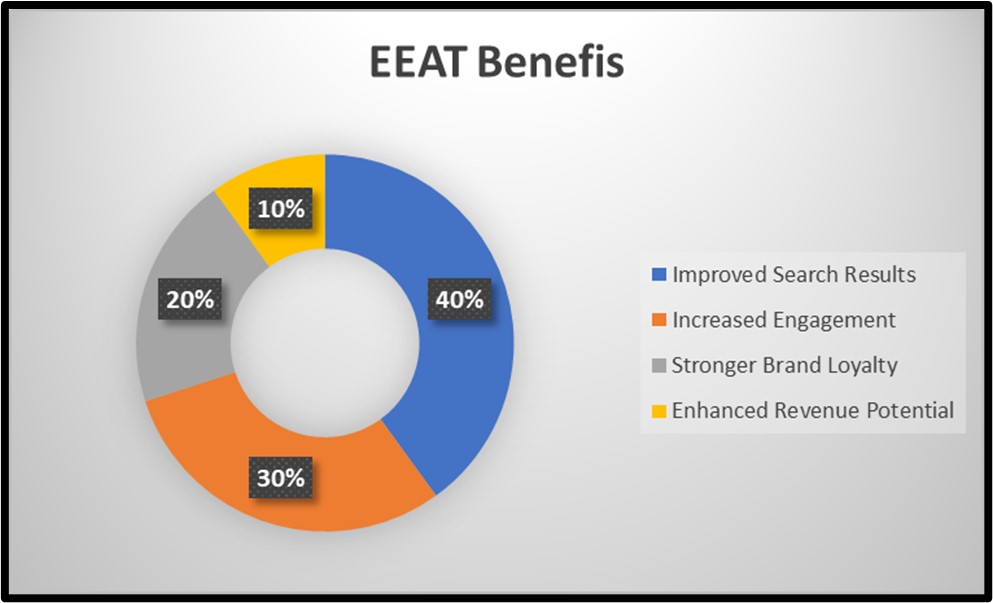
Building and Maintaining EEAT:
In the digital marketing niche, several websites showcase strong E-E-A-T across various aspects. Here are a few examples with specific strengths:
Strong E-A-T Examples in Digital Marketing Niche
| Website | Expertise | Authoritativeness | Trustworthiness | Experience |
| Moz (moz.com) | Leading SEO & marketing experts, in-depth articles, research reports | Industry thought leader contributions, awards, community forum | Transparent pricing, ethical marketing, data-driven insights | Runs annual conferences, hosts long-running MozBar tool, actively engages with community |
| Backlinko (backlinko.com) | Renowned SEO expert founder (Brian Dean), proven results | Cited by other websites, industry events participation | Detailed case studies, data-driven analysis, clear explanations | Brian Dean shares personal SEO experiments & learnings, years of industry experience |
| Search Engine Land (searchengineland.com) | Top SEO professionals & journalists, industry coverage | Widely recognized source, quoted by major publications | Strict editorial guidelines, balanced reporting, avoids clickbait | Covers industry news & trends for years, journalists draw on their own experience |
| Ahrefs (ahrefs.com) | Industry-leading SEO tools & resources, experienced team | In-depth guides, webinars, expert insights, data-driven analysis | Data accuracy, transparent pricing, ethical SEO practices | Offers free tools & resources, actively analyzes industry changes based on data & experience |
| Neil Patel (neilpatel.com) | Renowned digital marketing influencer, extensive experience | High website traffic, industry expert contributions | Actionable strategies, transparent advice (occasional self-promotion) | Shares personal marketing campaigns & results, years of consulting experience with various brands |
Resources & Tools to Evaluate and Improve Your Online EEAT
- Evaluating and improving EEAT is an ongoing process.
- No single tool or metric can definitively measure EEAT.
- Focus on delivering high-quality content, building trust with your audience, and adhering to ethical practices.
| Resource/Tool | Purpose | Metrics Assessed |
| Google Search Console: https://search.google.com/search-console/about | Tracks website performance and search visibility. | Organic traffic, clicks, impressions, keyword rankings, core web vitals, mobile-friendliness. |
| Moz Domain Authority (DA): https://moz.com/domain-analysis | Estimates website authority based on backlinks. | Domain authority, linking domains, linking root domains. |
| Ahrefs Backlink Checker: https://ahrefs.com/backlink-checker | Analyzes website backlinks and their quality. | Backlink profile, referring domains, domain rating (DR), anchor text distribution. |
| Semrush Brand Monitoring: https://www.semrush.com/ | Tracks brand mentions and sentiment online. | Brand mentions, sentiment score, top-performing content, social media engagement. |
| Buzzsumo Content Analyzer: https://buzzsumo.com/ | Analyzes content performance and popularity. | Social shares, comments, backlinks, estimated reach. |
| Google Analytics: https://analytics.google.com/analytics/academy/course/6 | Tracks website traffic and user behavior. | User demographics, page views, bounce rate, conversion rates, sources of traffic. |
| GTmetrix: https://gtmetrix.com/ | Measures website performance and speed. | Page load time, YSlow score, Lighthouse score, image optimization, caching. |
| Schema.org Markup Validator: https://validator.schema.org/ | Checks for structured data implementation errors. | Structured data errors, rich snippet eligibility. |
| Google My Business: https://www.google.com/business/ | Manages online business presence and local SEO. | Business profile completeness, customer reviews, engagement with reviews. |
5. Case Studies and Real-World Examples:
High-EAT Examples Across Industries: Medical, Real Estate, Agriculture, High-Profile Individuals
Medical:
1) Websites:
- Mayo Clinic (mayoclinic.org): Years of experience in patient care, extensive research and publications, renowned medical experts, rigorous editorial process.
- National Institutes of Health (nih.gov): Decades of research and data collection, government-backed authority, expert panels review information, commitment to transparency.
2) Individuals:
- Dr. Ashish Jha: Extensive experience in public health and policy, leadership roles in healthcare organizations, frequent media appearances, data-driven analysis.
- Dr. Atul Gawande: Surgeon with years of experience, published author and thought leader, advocates for patient-centered care, shares personal insights in writing.
Real Estate:
1) Websites:
- National Association of Realtors (nar.realtor): Over a century of experience in real estate, established code of ethics, educational resources, diverse member network.
- Zillow (zillow.com): Years of data collection and analysis, market trends insights, user reviews and testimonials, platform used by millions.
2) Individuals:
- Barbara Corcoran (https://twitter.com/BarbaraCorcoran): Decades of experience in real estate investing and development, television appearances showcase expertise, shares business lessons based on personal experiences.
- Gary Keller: Years as a real estate agent and leader, founded Keller Williams Realty, motivational speaker, shares leadership and market insights from years of experience.
Agriculture:
1) Websites:
- U.S. Department of Agriculture (usda.gov): Decades of research and data collection, experienced scientists and experts, field studies and ongoing monitoring, information tailored to various stakeholders.
- National Sustainable Agriculture Information Service (attra.ncat.org): Years of promoting sustainable practices, diverse network of farmers and experts, case studies and resources based on practical experience.
2) Individuals:
- Raj Patel: Extensive research and writing on food systems, years of activism and engagement with farmers, shares personal experiences and critical analysis.
- Vandana Shiva: Decades of experience in environmental activism and sustainable agriculture, founded Navdanya organization, shares personal stories and calls for action based on experience.
High-Profile Individuals:
Entrepreneurs:
- Mark Zuckerberg ([invalid URL removed]): Years of experience building and leading Facebook (now Meta), personal involvement in product development, shares insights into tech industry and company culture.
- Satya Nadella ([invalid URL removed]): Extensive experience in technology and leadership, transformed Microsoft’s cloud strategy, shares leadership lessons and vision for the future.
Scientists:
- Jane Goodall (https://twitter.com/JaneGoodallInst): Decades of experience studying chimpanzees, founded conservation organization, shares personal stories and insights based on years of fieldwork.
- Neil deGrasse Tyson (https://twitter.com/neiltyson): Extensive experience in astrophysics, engaging science communicator, shares personal anecdotes and humor to explain complex concepts.
The Future of EEAT: Navigating the Evolving Search Landscape
EEAT in 2024 and Beyond:
Emphasis on User Experience:
- Google’s focus will shift beyond “content quality” to “user experience.” Websites that prioritize user engagement, accessibility, and overall satisfaction will have an edge.
- AI-Powered Analysis: Expect more sophisticated AI tools to analyze content depth, user interactions, and author background, providing deeper insights into EEAT.
- Evolving Search Landscape: Google’s Search Generative Experience is just the beginning. Expect new search features and interfaces that challenge traditional content formats and elevate user-centricity.
Staying Informed and Adapting Strategies:
- Embrace Multifaceted Metrics: Move beyond traditional SEO metrics like backlinks and focus on user engagement, time spent on site, and click-through rates to gauge EAT effectively.
- Invest in User Experience: Prioritize website design, mobile-friendliness, and intuitive navigation to enhance user experience and search ranking potential.
- Become a Thought Leader: Share unique insights, engage in industry discussions, and build a reputation as a credible source to establish authoritativeness and expertise.
- Leverage AI Tools: Utilize AI-powered content analysis tools to identify areas for improvement and stay ahead of evolving EAT evaluation methods.
- Maintain Transparency and Trust: Be transparent about your expertise, sources, and funding. Prioritize data accuracy and ethical practices to build user trust.
Predictions:
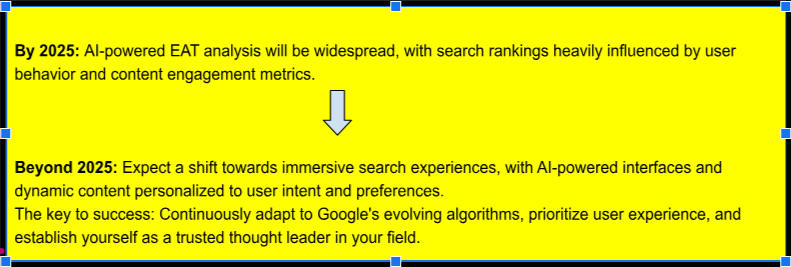
Conclusion
In conclusion, E-E-A-T (Experience, Expertise, Authoritativeness, and Trustworthiness) plays a crucial role in elevating your online presence and establishing credibility with both users and search engines. By understanding and implementing strategies to demonstrate expertise, authority, and trustworthiness, you can enhance your visibility, attract more organic traffic, and build long-lasting relationships with your audience. Prioritize E- E-A-T principles in your digital marketing efforts, and watch your online presence flourish.
As Google morphs and user needs shift, EEAT transforms from a static target to a dynamic dance. Navigate this by embracing user-centricity, thinking beyond content creation, establishing thought leadership, and continually adapting. Prioritize intuitive design, transparency, and ethical practices. Remember, the future of EEAT favors those who adapt, innovate, and prioritize user experience. Let’s dance together!
Also Read: Convert 70% visitors to leads with SEO Outreach for B2B and B2C – Ennoble Technologies
Dominate the Online Marketplace: Revolutionary Digital Marketing Solutions for E-Commerce Triumph!
The Evolving Landscape of E-Commerce
The world of e-commerce is like a dynamic and ever-changing ocean, with trends and technologies shifting like tides. In this blog post, we will explore how to not just survive but thrive in this vast digital marketplace. Welcome to a journey of revolutionary digital marketing solutions for e-commerce success.
The Need for Revolutionary Digital Marketing
Imagine you have a treasure trove of products waiting to be discovered, but your online store is hidden in the depths of search engine results. To rise above the digital noise, you need revolutionary digital marketing strategies. Let’s embark on this adventure together.
Understanding Your Audience

Segmentation: The Key to Success
In the vast sea of online shoppers, it’s crucial to divide them into manageable groups. This is where segmentation comes in. Just like a fisherman selects the right bait, you need to understand your audience’s preferences and behavior to serve them effectively.
Analyzing Customer Behavior in the Digital Age
Today’s consumers leave digital footprints everywhere they go, from social media likes to search queries. Dive deep into analytics to understand what makes your customers tick. The better you understand them, the easier it is to craft tailored marketing campaigns.
Crafting a Customer Persona That Converts
Meet Sarah, a 32-year-old fitness enthusiast who prefers shopping on her mobile phone during her commute. She’s not just a statistic; she’s your ideal customer persona. Learn how to create personas that bring your audience to life and guide your marketing efforts.
Content is King: Crafting Compelling E-Commerce Content

The Power of Engaging Product Descriptions
Your product descriptions are your sales pitch. Imagine you’re a storyteller trying to captivate your audience. We’ll delve into the art of crafting compelling product descriptions that not only inform but also enthrall.
Leveraging Visual Content for Impact
In a visually-driven digital world, images and videos are your secret weapons. We’ll explore how to use stunning visuals to showcase your products, leaving your customers craving more.
Blogging for E-Commerce: A Hidden Gem
Blogging isn’t just for influencers and news outlets. Discover how a well-crafted blog can drive traffic, engage your audience, and boost your e-commerce sales.
User-Generated Content: Harnessing the Voice of the Customer
Your customers are your biggest advocates. Learn how to encourage them to create content that sings praises of your products, and watch your brand’s reach expand.
Optimizing for Search Engines: SEO Magic Unveiled

On-Page SEO Essentials
From meta tags to keyword optimization, we’ll demystify on-page SEO, ensuring your e-commerce website shines on search engine results pages.
Off-Page SEO: Building a Web of Influence
Off-page SEO isn’t about what you do on your website but what others say about it. Discover the power of backlinks, online reputation management, and influencer partnerships.
Voice Search and Mobile Optimization
“Hey Siri, find me the best running shoes.” Voice search is on the rise, and mobile optimization is no longer optional. We’ll navigate the changing tides of search behavior.
Paid Advertising: Smart Strategies for E-Commerce

Google Ads: A Treasure Trove for E-Commerce
Unlock the potential of Google Ads as we delve into strategies, keyword research, and ad campaigns that will catapult your products into the limelight.
Social Media Advertising: Beyond the Boost Button
Boosting posts is just the tip of the iceberg. We’ll explore advanced social media advertising techniques to connect with your audience on a deeper level.
Remarketing and Conversion Rate Optimization
Ever wondered why those shoes you viewed online keep following you around? That’s remarketing in action. Learn how to use this powerful tool and optimize your conversion rates.
Social Media Domination: Winning the Hearts of Digital Shoppers

Choosing the Right Platforms for Your Brand
Not all social media platforms are created equal. Discover which ones align with your brand’s values and resonate most with your audience.
Creating Shareable Content: The Virality Factor
Go viral or go home? We’ll dissect what makes content shareable and how to create posts that your customers can’t help but share.
Community Building and Influencer Marketing
In the vast digital ocean, building a loyal community can be your lifeboat. We’ll explore how to foster a sense of belonging and tap into the influence of digital celebrities.
Data-Driven Decisions: Analytics and Performance Tracking

The Tools of the Trade
Imagine sailing without navigation tools. Analytics and tracking are your compass. We’ll introduce you to the essential tools every e-commerce marketer should have in their arsenal.
Interpreting Key Metrics for E-Commerce Success
Numbers tell a story. We’ll teach you how to read that story, from click-through rates to conversion funnels, and make data-driven decisions that steer your e-commerce ship toward success.
A/B Testing: The Scientific Approach
Do you know what really works for your audience? A/B testing is the scientist’s method to discover what resonates best with your customers. Get ready to experiment and optimize
Conclusion
Embracing Change and Staying Ahead
In the ever-evolving e-commerce landscape, the only constant is change. Embrace it. Stay agile, and you’ll always be one step ahead of the competition.
The Future of E-Commerce Marketing
As we sail toward the horizon, we catch a glimpse of the future. From AI-driven personalization to immersive shopping experiences, the future of e-commerce marketing is an exciting journey.
FAQs

Q: What is the most important factor in e-commerce marketing?
A: Understanding your audience is paramount. Without this knowledge, all other efforts may fall flat.
Q: How can I improve my product descriptions?
A: Focus on benefits, not just features. Paint a vivid picture of how the product will enhance the customer’s life.
Q: Which social media platform is best for e-commerce?
A: It depends on your target audience. Facebook and Instagram are often great choices, but niche platforms can work wonders too.
Q: What’s the role of customer reviews in e-commerce?
A: Customer reviews build trust and social proof. Encourage and showcase them on your website.
Q: Can I succeed in e-commerce without paid advertising?
A: While organic methods are possible, paid advertising can significantly accelerate your success.
Also Read: Unveiling the Must-Have Analytics Tools for E-commerce Success – Ennoble Technologies
Unveiling the Must-Have Analytics Tools for E-commerce Success
Introduction
In the dynamic realm of e-commerce, data is the compass that guides business owners towards success. Analytics tools provide invaluable insights into customer behavior, website performance, and sales trends. By harnessing the power of these tools, e-commerce owners can fine-tune their strategies, enhance user experiences, and ultimately maximize revenue. This comprehensive guide explores the essential analytics tools that every e-commerce entrepreneur should have in their toolkit.
Why Analytics Tools are Crucial for E-commerce Success

Data-driven decision-making has become a cornerstone of modern business strategies. E-commerce owners who utilize analytics tools gain a competitive advantage by understanding their customers’ preferences, identifying pain points, and optimizing their online storefront.
Unveiling Customer Behavior
Analytics tools unveil intricate details about how customers interact with your e-commerce website. This data helps you understand what products or pages are most popular, which buttons are clicked, and where users drop off during the purchasing process.
Optimizing User Experiences
By analyzing user behavior and feedback, you can enhance the user experience on your website. Streamlined navigation, personalized recommendations, and responsive design all contribute to higher customer satisfaction and increased conversions.
Tracking Sales and Revenue
E-commerce analytics tools provide real-time insights into your sales and revenue performance. This allows you to monitor the success of your marketing campaigns, identify trends, and make informed decisions about inventory and pricing.
Must-Have Analytics Tools for E-commerce Owners

Let’s delve into the essential analytics tools that empower e-commerce owners to gather actionable insights and drive business growth.
1. Google Analytics
Google Analytics is the foundation of e-commerce analytics. It offers a wealth of information about website traffic, user behavior, and conversion rates. With enhanced e-commerce tracking, you can dive deeper into shopping behavior, including cart abandonment and product performance.
2. Google Search Console
Google Search Console provides crucial data about your website’s performance in search results. It highlights keywords that drive traffic to your site, tracks click-through rates, and alerts you to any indexing issues.
3. Hotjar
Hotjar offers heatmaps, session recordings, and user surveys to provide a comprehensive view of user interactions. Heatmaps show where users click and scroll, while session recordings offer a firsthand look at how users navigate your website.
4. KISSmetrics
KISSmetrics specializes in tracking individual user behavior. It offers insights into user paths, conversion rates, and customer segmentation, enabling highly targeted marketing campaigns.
5. Crazy Egg
Crazy Egg provides heatmaps, scroll maps, and overlay reports to visualize user engagement on your site. These visual tools help you identify areas that need improvement and optimize your website’s layout.
6. Mixpanel
Mixpanel focuses on event-based analytics, allowing you to track specific actions users take on your website. This data is valuable for understanding user journeys and optimizing the customer experience.
7. Optimizely
Optimizely is an A/B testing platform that enables you to test different variations of your website. By experimenting with different layouts, designs, and copy, you can identify the most effective changes for increasing conversions.
8. WooCommerce Analytics
For e-commerce businesses using the WooCommerce platform, WooCommerce Analytics offers insights into sales trends, customer behaviors, and product performance. It integrates seamlessly with your online store.
9. Facebook Analytics
If you’re utilizing Facebook for advertising, Facebook Analytics provides in-depth insights into ad performance, audience engagement, and customer demographics. This data informs your ad strategies and targeting efforts.
10. Shopify Analytics
Similar to WooCommerce Analytics, Shopify Analytics is tailored for businesses using the Shopify platform. It offers reports on sales, traffic sources, and customer behavior, aiding decision-making.
Choosing the Right Analytics Tools

Selecting the right analytics tools depends on your business goals, website platform, and the specific insights you’re seeking. Consider the following when making your choices:
- Compatibility: Ensure the tools integrate seamlessly with your e-commerce platform.
- Features: Evaluate the features each tool offers and how they align with your analytics needs.
- Ease of Use: Opt for tools with intuitive interfaces and user-friendly dashboards.
- Cost: Consider your budget and the value each tool brings to your business.
FAQs about E-commerce Analytics Tools

Q: Are these tools suitable for businesses of all sizes?
A: Yes, many of these tools offer plans that cater to businesses of varying sizes. Start with tools that match your current needs and upgrade as your business grows.
Q: Can I use multiple analytics tools simultaneously?
A: Absolutely. In fact, using a combination of tools can provide a more comprehensive view of your e-commerce performance and customer behavior.
Q: Are there any free alternatives to these paid analytics tools?
A: Yes, some tools offer free versions with limited features. Google Analytics and Google Search Console, for instance, provide robust analytics capabilities at no cost.
Q: How often should I review my analytics data?
A: Regularly reviewing your data, such as weekly or monthly, allows you to identify trends, make timely adjustments, and capitalize on opportunities.
Conclusion
E-commerce analytics tools are the compass that guides you through the intricate landscape of online business. By harnessing the power of data, you can optimize your strategies, delight your customers, and pave the way for sustained success. Select the tools that align with your business objectives, and watch as your e-commerce venture flourishes.
Also Read: Discover the Best Alternatives to PayPal for Your E-commerce Business – Ennoble Technologies
Discover the Best Alternatives to PayPal for Your E-commerce Business
Introduction
In the world of e-commerce, providing convenient and secure payment options is essential to meet the varying needs of customers. While PayPal is a popular choice, there are numerous alternatives available that offer distinct features and benefits. This article will guide you through a selection of reliable alternatives to PayPal, allowing you to diversify your payment options and enhance the shopping experience for your customers.
The Need for Diverse Payment Options in E-commerce

As the e-commerce landscape continues to evolve, so do customer expectations. Offering a range of payment methods ensures you don’t alienate potential buyers who may have preferences outside of PayPal.
Understanding Customer Preferences
Some customers prefer using credit or debit cards directly, while others might prefer digital wallets or even cryptocurrency. By accommodating these preferences, you create a frictionless checkout experience that encourages conversions.
Global Accessibility
PayPal might not be accessible or preferred in every country. Integrating alternative payment methods can open up your e-commerce store to a broader international audience.
Top Alternatives to PayPal for E-commerce

Let’s explore some of the most reliable and widely-used alternatives to PayPal that cater to different customer preferences.
1. Stripe
Stripe is known for its developer-friendly platform, making it an excellent choice for businesses that want to customize their payment process. It supports various payment methods and offers robust security features.
2. Square
Square is popular for its simple point-of-sale solutions, but it also offers online payment options. With Square, you can seamlessly integrate in-person and online transactions, streamlining your overall business operations.
3. Amazon Pay
For businesses with a significant portion of their customers on Amazon, Amazon Pay offers a familiar and secure payment option. Customers can use their Amazon credentials to complete purchases on your e-commerce site.
4. Apple Pay
With the rise of mobile shopping, Apple Pay provides a quick and secure way for iOS users to make purchases. Its seamless integration with Apple devices makes the checkout process convenient.
5. Google Pay
Similar to Apple Pay, Google Pay simplifies mobile transactions for Android users. Its integration with Google accounts enhances user convenience, leading to higher conversion rates.
6. Skrill
Skrill specializes in international transactions and supports over 40 currencies. It also offers a prepaid card option, allowing users to access their funds easily.
7. Authorize.Net
Authorize.Net is a long-standing player in the payment processing industry. It offers a suite of features, including fraud detection and subscription management, making it suitable for businesses of all sizes.
8. 2Checkout
2Checkout (now Verifone) is a global payment platform that supports multiple payment methods, including credit cards, PayPal, and more. It offers a user-friendly interface and supports over 87 currencies.
9. Shopify Payments
If you’re using the Shopify platform, Shopify Payments provides a seamless payment solution directly integrated into your store. It eliminates the need for third-party gateways and simplifies your financial processes.
10.Payoneer
Payoneer is tailored to freelancers and businesses engaged in cross-border transactions. It provides multi-currency receiving accounts, making it easier to manage payments from international clients.
Choosing the Right Alternative
Selecting the ideal alternative to PayPal depends on factors such as your target audience, business size, and international reach. Consider these factors when making your decision:
- Customer Preferences: What payment methods do your customers prefer?
- Geographic Reach: Do you serve a global audience?
- Integration Ease: How seamlessly can the payment method be integrated into your e-commerce platform?
- Security: What security features does the alternative offer to protect customer data?
FAQs about E-commerce Payment Alternatives

Q: Are these alternatives more secure than PayPal?
A: Yes, many of these alternatives offer similar or enhanced security features, ensuring the safety of both customers’ personal information and your business transactions.
Q: Can I offer multiple payment options on my e-commerce site?
A: Absolutely. Most e-commerce platforms allow you to integrate multiple payment gateways, giving customers the flexibility to choose their preferred method.
Q: Do these alternatives have fees similar to PayPal’s?
A: Fees vary among payment gateways. It’s essential to review the fee structure of each alternative and assess how they align with your business goals.
Q: How can I ensure a smooth transition to a new payment gateway?
A: Choose an alternative that offers seamless integration with your e-commerce platform. Additionally, communicate the change to your customers and provide guidance on using the new payment method.
Conclusion
In conclusion, while PayPal has been a go-to payment solution for e-commerce businesses, there’s a world of alternatives offering unique advantages. Whether you’re looking for developer-friendly options, international transaction support, or seamless integration with existing platforms, these alternatives have you covered. Consider your business’s specific needs, target audience, and growth plans to determine the best alternative to PayPal for your e-commerce venture. Embrace the power of choice and enhance your customer’s payment experience today!
Also Read: Drive Growth E-commerce with Online Advertising: A Comprehensive Guide – Ennoble Technologies
Mobile Friendliness: Your Key to Connecting with Users on the Go!
In today’s fast-paced world, where smartphones have become an integral part of our lives, it’s essential for businesses and website owners to prioritize mobile friendliness. With a significant portion of web traffic originating from mobile devices, ensuring that your website is mobile-friendly is not just a nice-to-have feature—it’s a necessity. In this blog post, we’ll explore the importance of mobile friendliness and provide practical tips to help you create a seamless mobile experience for your users.
The Significance of Mobile Friendliness:

The digital landscape is rapidly evolving, and mobile devices have taken center stage in our lives. As people increasingly rely on smartphones and tablets to browse the internet, the significance of mobile friendliness cannot be overstated. In this section, we will explore why mobile friendliness is a game-changer for businesses and website owners. From user behavior to search engine rankings, we’ll uncover the compelling reasons why optimizing your website for mobile devices is essential in today’s mobile-driven world. Let’s discover the true significance of mobile friendliness and its impact on your online success.
a. Changing User Habits: The way users interact with the internet has shifted, with mobile devices becoming the primary means of accessing information, shopping, and engaging with content.
b. User Expectations: Users expect a smooth and intuitive browsing experience on their smartphones. If a website isn’t optimized for mobile, they’re likely to leave and find a competitor that offers a better mobile experience.
c. Google’s Mobile-First Indexing: Google now prioritizes mobile-friendly websites in search results, making mobile optimization crucial for search engine visibility and organic traffic.
Key Elements of Mobile-Friendly Design:

As the majority of internet users access websites through their smartphones, it’s crucial for businesses and website owners to prioritize mobile-friendly design principles. In this section, we will explore the key elements of mobile-friendly design and how they contribute to a seamless user experience. From responsive layouts to intuitive navigation, we’ll delve into the essential components that ensure your website looks and functions flawlessly on mobile devices. Let’s uncover the fundamental elements that make a design truly mobile-friendly and optimize your website for success.
a. Responsive Design: Implementing a responsive design ensures that your website adapts and displays correctly on various screen sizes and devices.
b. Clear and Streamlined Navigation: Simplify menus, use intuitive icons, and ensure that users can easily navigate your website with their fingers.
c. Optimized Page Speed: Mobile users crave fast-loading websites. Compress images, minify code, and use caching techniques to improve page load times.
d. Readability and Scannability: Optimize your content for mobile consumption by using concise paragraphs, bullet points, and headings to improve readability and facilitate quick scanning.
Testing and Optimizing:

Whether you’re a seasoned webmaster or just starting your online journey, the process of testing and optimizing is essential for ensuring your website’s success. In this section, we’ll dive into the exhilarating world of testing and optimization, where we uncover hidden insights, overcome challenges, and fine-tune your website to deliver an exceptional user experience. Let’s learn about unlocking your website’s full potential through meticulous testing and strategic optimization. Elevate your website’s performance to new heights together!
a. Device Testing: Regularly test your website on a range of mobile devices and browsers to ensure consistent performance and appearance.
b. User Feedback: Encourage users to provide feedback on their mobile experience and use their insights to make necessary improvements.
c. Analytics and Heatmaps: Utilize analytics tools and heatmaps to gain insights into user behavior, identify pain points, and optimize your website accordingly.
Mobile SEO Considerations:

With mobile devices becoming the primary gateway to the internet, it’s essential for businesses and website owners to prioritize mobile SEO considerations. Let’s learn about the intricacies of mobile SEO, uncovering strategies and insights that will propel your website to new heights in search engine rankings. Let’s dive into the dynamic realm of mobile SEO and unleash the power of mobile search!
a. Mobile-Friendly Label: Aim for the “Mobile-Friendly” label in search results to assure users that your website provides a seamless mobile experience.
b. Mobile-Specific Keywords: Optimize your content for mobile search queries by including relevant mobile-specific keywords.
c. Local Optimization: Capitalize on mobile’s local search dominance by optimizing your website for local keywords and implementing location-specific features.
Conclusion:
Mobile friendliness is no longer optional—it’s a fundamental aspect of providing a positive user experience. By adopting a mobile-first mindset, implementing responsive design, optimizing page speed, and continuously testing and refining, you’ll connect with users on the go, increase engagement, and stay ahead of the competition. Embrace mobile friendliness as a key strategy to unlock your website’s full potential and make a lasting impression on your mobile audience.
Remember, in this mobile-centric world, your website’s mobile friendliness can make all the difference. So, let’s create amazing mobile experiences together!
Also Read: The 5 Best Social Media Platforms for Business In 2023 – Ennoble Technologies
Top Tips for B2B Keyword Research with Ubersuggest
B2B keyword research is crucial for every business. It is necessary to get more leads, increase website traffic, and improve search engine rankings. With the help of powerful tools like Ubersuggest, businesses can get and use effective keyword strategies to reach their target audience and achieve their market goals. This article will explore top tips for B2B keyword research with Ubersuggest. Also, we will learn how you can leverage this powerful tool to improve keyword strategy and grow more with your business.
What is B2B Keyword Research?
B2B is business-to-business, which refers to marketing and selling products or services from one business to another. B2B keyword research is the process of identifying and analyzing the keywords that businesses use to search for products or services. These keywords are relevant to the needs of their business. Ubersuggest is a helpful tool that anyone can use to conduct effective keyword research. The tool will help you identify the right keywords, analyze their competitors, and develop keyword strategies that drive more traffic and generate higher leads. Keyword search volume, keyword difficulty, and CPC (cost per click) are among the excellent features and services it provides.
7 Top Tips for B2B Keyword Research with Ubersuggest
1. Understanding Who Your Target Audience Is
The first step in B2B keyword research is identifying your target audience. This means understanding their search intent as well. Ubersuggest can be used to know the most common search queries and topics your target audience seeks.
Understanding customers’ search intent helps in knowing their interests which will help you create relevant content that satisfies their needs. You can gather information through different methods, such as customer surveys, website analytics, and other market research.
2. Identifying the Right Keywords
Once you have closely examined your target audience, the next step should be identifying the right keywords. Ubersuggest offers features that can help you conduct keyword research and analyze keyword metrics. However, there are different keywords: short-tail, long-tail, and branded.
You can rely on this tool to find relevant keywords that are easy to rank and have a high search volume. You can also try social media and customer feedback to gain valuable information.
3. Creating a List of Potential Keywords
With the information you collected, you can start developing a list of potential keywords and phrases that your target audience may use to search for your products or services. This list can be used as a starting point for keyword research.
4. Analyzing Your Competitors
Analyzing your competitors’ websites can help you go ahead with them. Identifying your top competitors is beneficial in analyzing their keywords and content to understand their strengths and weaknesses.
Ubersuggest can be used to compare your website’s performance with your competitors. By analyzing your competitors, you can know the weaknesses in your content strategy and improve your keyword research strategy.
5. Creating a Keyword Strategy
After you have identified the right keywords and analyzed your competitors, the next thing to do is to create a keyword strategy. This involves developing a list of high-value keywords and putting them into relevant content.
With the help of this research tool, you can track your keyword ranking and make significant progress over time. Also, it will help you change your strategy and improve your website’s performance.
6. Using Long-Tail Keywords
In addition, businesses should also focus on long-tail keywords – such as specific keyword phrases that are usually less competitive but are more targeted to their ideal customer. The tool can help businesses identify and use long-tail keywords in their keyword strategy.
7. Prioritizing Commercial Intent Keywords
At last, one should focus on keywords with commercial intent that indicate what a user is searching for to get the product or service. Identifying and prioritizing keywords with commercial intent in their keyword strategy can help generate effective ideas.
Additional Tips for Effective B2B Keyword Research
Apart from that, here are some additional tips for making B2B keyword research effective:
- Stay up-to-date with the latest trends in your industry and changes in search engine algorithms.
- Continuously analyze and replan your keyword strategy to improve your website’s performance.
Conclusion
B2B keyword research is a crucial aspect of any business’s marketing strategy. Using powerful tools like Ubersuggest, businesses can make keyword research effective, identify keywords, analyze their competitors, and develop a keyword strategy that drives traffic and generates leads. By following the tips mentioned in this article, businesses can get better at doing B2B keyword research.

